HON HAI PRECISION IND T77H747 NFC Module User Manual rev 4
HON HAI Precision Ind. Co., Ltd. NFC Module rev 4
Contents
- 1. User Manual rev 4
- 2. User Manual rev 4.pdf
- 3. Users Manual rev2
- 4. User Manual
User Manual rev 4
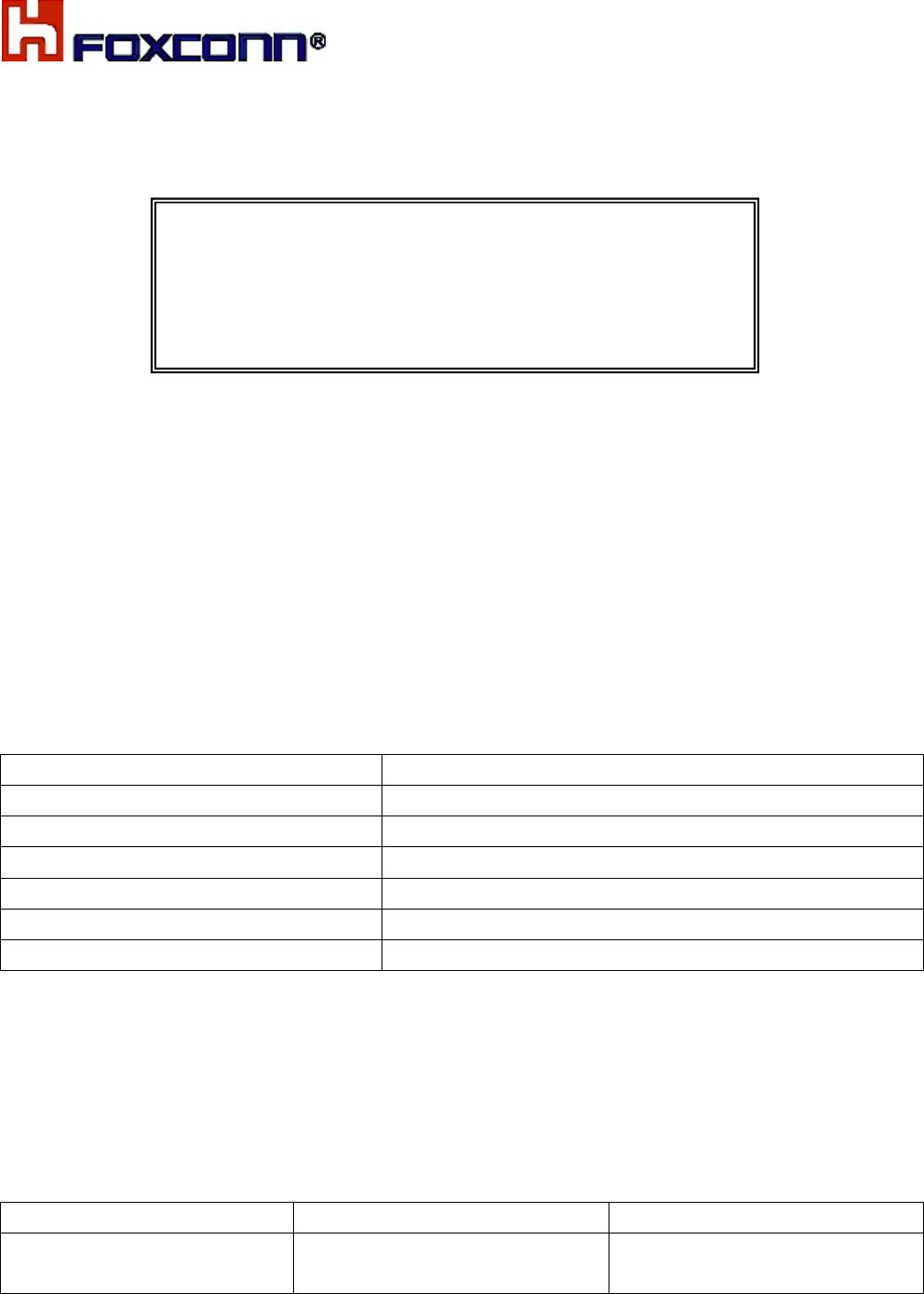
COMPANY CONFIDENTIAL
1
NFC
(Near Field Communication)
NXP NPC300 Module
Project Name
NFC (NXP NPC300) Module
Document Rev.
5.0
FOXCONN Part No.
T77H747.10
Module Rev. 005
FRU Part No. 01AX745
Customer Part No. SW10K97523
FOXCONN Label Rev 00S0
Prepared by Reviewed by Approved by
Bandy.Jiang Wei.Liao Chang-Fu Lin
Revision Note
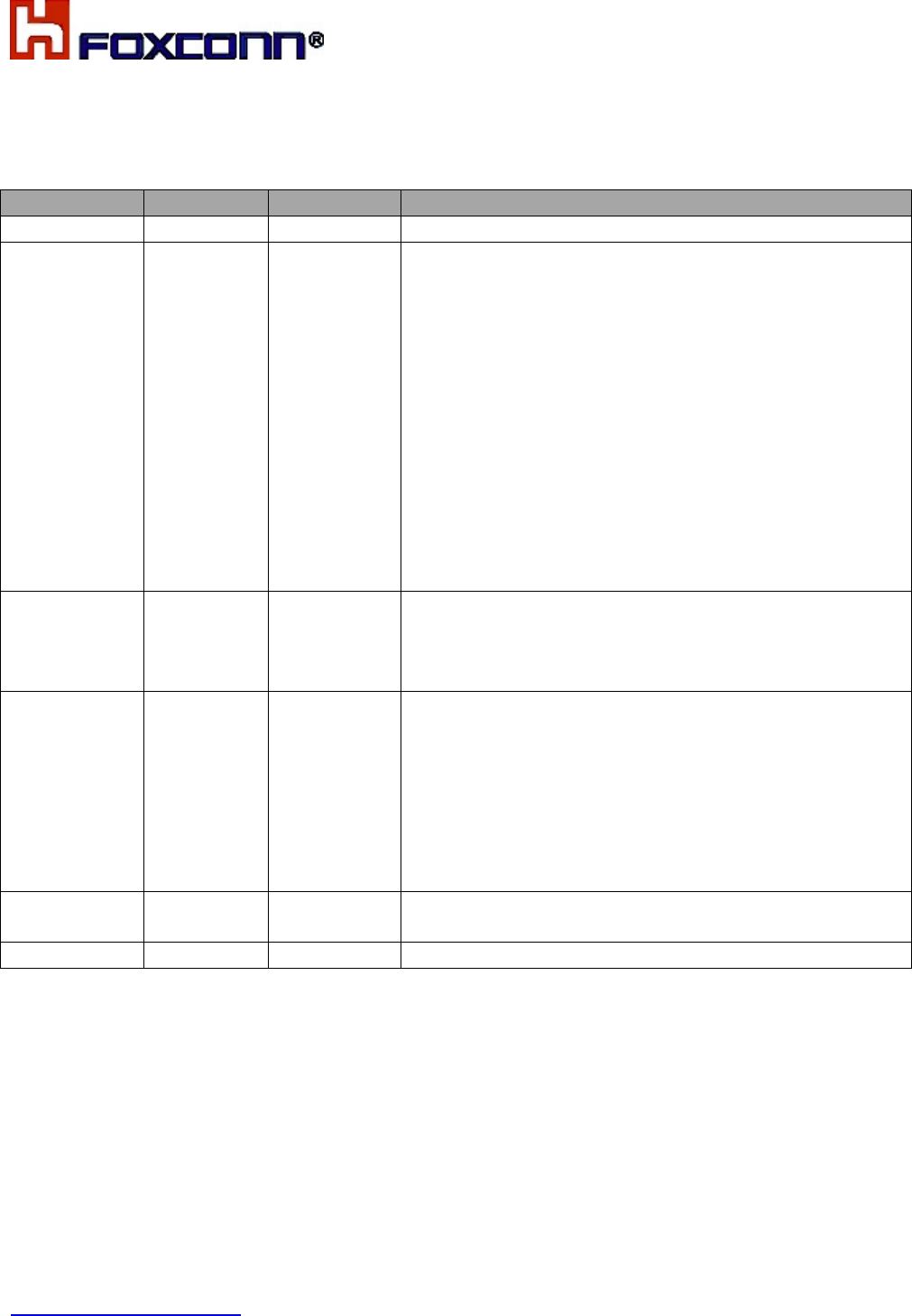
COMPANY CONFIDENTIAL
2
Revision History
T77H747.10 is made in China,
Manufactured by HongFuJin Precision Industry Co., LTD
Manufacture Site: ChongQing
http://www.foxconn.com
Revision Date Originator Comment
1.0 2016/01/28
Smile. Ming
Initial release
2.0 2016/04/20
Bandy.Jiang
1> Add pin 1 marking for mechanical drawing.
2> Add SM bus support in addition to I2C bus. (in
page 4,5)
3> Add description of pin9 (TX_PWR_REQ) signal
with active high 1.8V level output. (in page 15)
4> Change the PN of antenna connector from
BM05B-ACHSS-A-GAN-ETF(LF)(SN) to BM05B-
ACHKS-A-GAN-ETF(HF)
5> Update material in shielding drawing.
6> Following the latest schematic, update the
material description into BOM
7> Add Tray ID label, Carton label, Pallet label into
label information
8> Update packing information
3.0 2016/04/26
Bandy.Jiang
1> Update Module picture in page 18
2> Update packing information in page 23~24
3> Update vendor PN of host interface connector in
page 15
4.0 2016/06/24
Bandy.Jiang
1> Remove R5 from BOM.
2>
Change Foxconn project name from T77H747.00
to T77H747.10
3> Change FRU part No. from 00JT548 to
01AX745.
4> Based on above change list, update module
picture, BOM, label contents and packing
information.
5.0 2016/06/28
Bandy. Jiang
1> Change Host JST part number from ACHR-05V-
A-S to ACHR-05V-A-K(HF) in page 14

COMPANY CONFIDENTIAL
3
Content
1. INTRODUCTION ............................................................................................................................................................. 4
1.1
S
COPE
....................................................................................................................................................................... 4
1.2
F
UNCTION
.................................................................................................................................................................. 4
1.3
H
ARDWARE BLOCK DIAGRAM
....................................................................................................................................... 5
2. ELECTRICAL CHARACTERISTICS ............................................................................................................................. 6
2.1
OPERATING CONDITIONS
.............................................................................................................................................. 6
2.1
H
OST INTERFACE CHARACTERISTICS
.......................................................................................................................... 7
2.2
P
OWER
-
UP SEQUENCE
................................................................................................................................................ 8
2.3
P
OWER
-
DOWN SEQUENCE
........................................................................................................................................... 9
2.4
F
UNCTION TIMING CHARACTERISTICS
......................................................................................................................... 9
3. NFC CONTACTLESS STANDARD CONFORMANCE ............................................................................................ 10
3.1
F
REQUENCY INTEROPERABILITY
............................................................................................................................... 10
3.2
S
UPPORTED SMART CARD TYPES
.............................................................................................................................. 10
3.3
C
ONTACTLESS INTERFACE UNIT
................................................................................................................................ 11
4. MECHANICAL ARCHITECTURE ................................................................................................................................ 12
4.1
M
ODULE
M
ECHANICAL
D
RAWING
.............................................................................................................................. 12
4.2
A
NTENNA INTERFACE OF
NFC
MODULE
.................................................................................................................... 13
4.3.
H
OST INTERFACE OF
NFC
MODULE
......................................................................................................................... 15
4.4.
S
HIELDING
C
OVER OF
NFC
MODULE
....................................................................................................................... 18
4.5.
P
ICTURE OF
NFC
MODULE
....................................................................................................................................... 18
5. PCB PATTERN OF NFC MODULE ............................................................................................................................ 19
5.1
PCB
COMPONENT PLACEMENT
................................................................................................................................. 19
5.2
PCB
S
TACK
U
P AND
M
ATERIALS
.............................................................................................................................. 19
6. BOM (BILL OF MATERIALS) OF NFC MODULE ..................................................................................................... 20
7. MARKING INFORMATION .......................................................................................................................................... 21
8. PACKING INFORMATION ........................................................................................................................................... 23

COMPANY CONFIDENTIAL
4
1. Introduction
The T77H747.10 is an NFC module designed for integration in computer or portable
equipment and consumer devices compliant with NFC standards (NFC Forum, NCI, ISO/IEC
14443 and ISO/IEC 15693) etc. This module is based on NXP NPC300 solution, which is a
highly integrated transmission module for contactless communication at 13.56MHz.
1.1 Scope
The NFC module RF protocols supported:
NFCIP-1, NFCIP-2 protocol
NFC Forum device 1.3
ISO/IEC 14443A, ISO/IEC 14443B
ISO/IEC 15693/ICODE VCD mode
FeliCa PCD mode/PICC mode
MIFARE PCD encryption mechanism(MIFARE 1K/4K)
MIFARE PICC mode
NFC Forum tag (type 1/type 2/type 3/type 4/type V)
1.2 Function
NFC Features
- Reader & Writer mode
- Peer-to-Peer Communication mode
- Card emulation mode
I
2
C-bus and SM-bus compatible for host Interface
Windows 8 Logo Device Requirement compliant
- NFC Forum Wave1 Certification
- LLCP
- SNEP
Windows 10 Logo system Requirement compliant
- Peer to Peer Communication over 2cm distance less than 10cm
Modular certification
- FCC
- CE
- UL/CB
- meet other regulatory requirements (as defined by 108 countries)
(Remark: Regulatory Certification is not started at this phase)
Support Intel Windows 7/8.x/10 platform
RoHS and Green Compliant
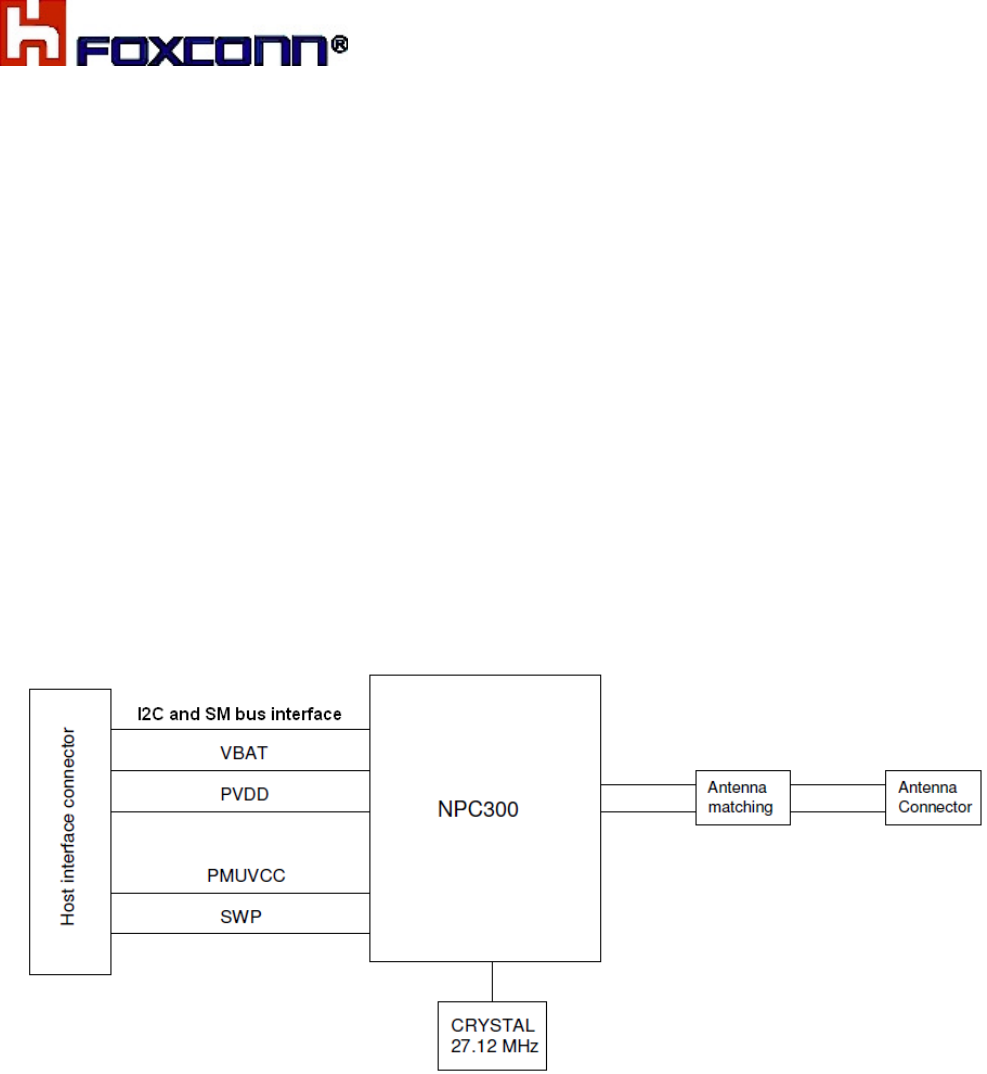
COMPANY CONFIDENTIAL
5
1.3 Hardware block diagram
The T77H747.10 NFC module is based on NXP NPC300 solution with includes ARM
microcontroller core, EEPROM, demodulator and decoder, power management unit, host
interface. This module is powered from the host (5V) and interfaces to the host with I
2
C -bus
compatible signals, on-board 27.12 MHz XTAL. Also includes on board low profile FPC/FFC
12pin connector for host interface and 5pin WTB antenna connector for antenna interface.
Form factor: 20.0mm x13.0mm x 2.1mm (typical) NFC module
Host Interface: I
2
C and SM bus compatible interface with 12-pin FPC connector
PCB: 4-layers HDI design
The functional block diagram is shown as below:
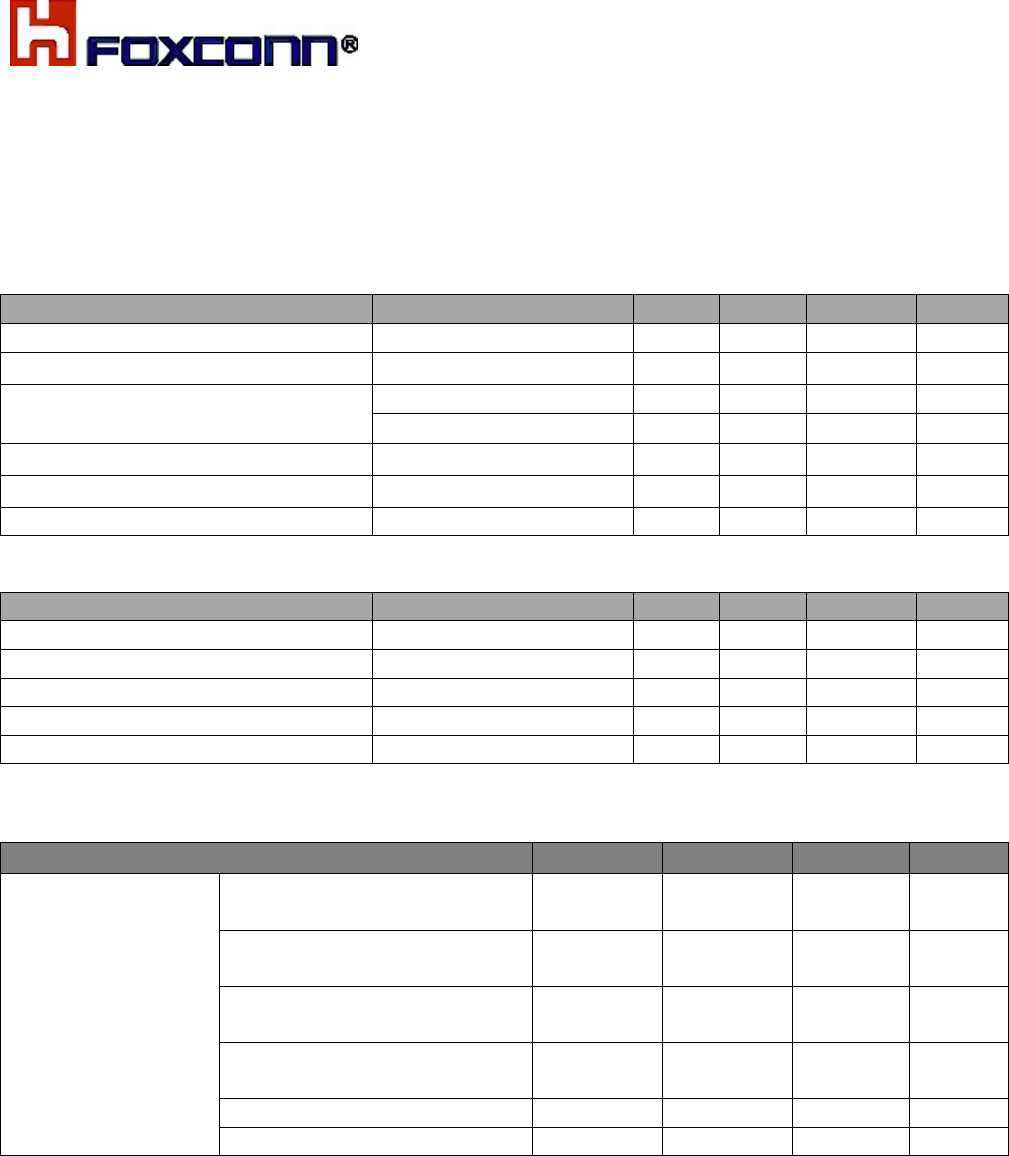
COMPANY CONFIDENTIAL
6
2. Electrical Characteristics
2.1 operating conditions
Absolute Maximum Rating
Recommended Operating Condition
Symbol Condition Min. Typ. Max Unit
VBAT Respect to GND 4.5 5.0 5.5 V
PVDD Respect to GND 3.0 3.3 3.6 V
PMUVCC Respect to GND 1.62 1.8 1.98 V
VDD Respect to GND 1.65 1.8 1.95 V
VDD(SIM) Respect to GND 1.62 1.8 1.98 V
Remark: VDD for TX_PWR_REQ referred voltage, VDD(SIM) for SWIO_UICC referred voltage.
Power Consumption
Condition Min. Typ. Max Unit
Power
consumption
Reader mode
(PCD active) -- 130 -- mA
Reader mode
(PCD standby) -- 50 -- uA
Peer to peer mode
(active) -- 130 -- mA
Peer to peer mode
(standby) -- 50 -- uA
Continue TX mode -- 130 -- mA
Hard Power Down mode -- 10 -- uA
Symbol Condition Min. Typ. Max Unit
VBAT Respect to GND -- 5.0 6.0 V
PVDD Respect to GND -- 3.3 4.35 V
ESD Limit Level HBM -- -- +/-1.0 KV
CDM -- -- +/-500 V
Operating Temperature -- 0 +25 +70 ℃
Storage Temperature -- -20 +25 +85 ℃
Storage Humidity -- 0 -- +85 %
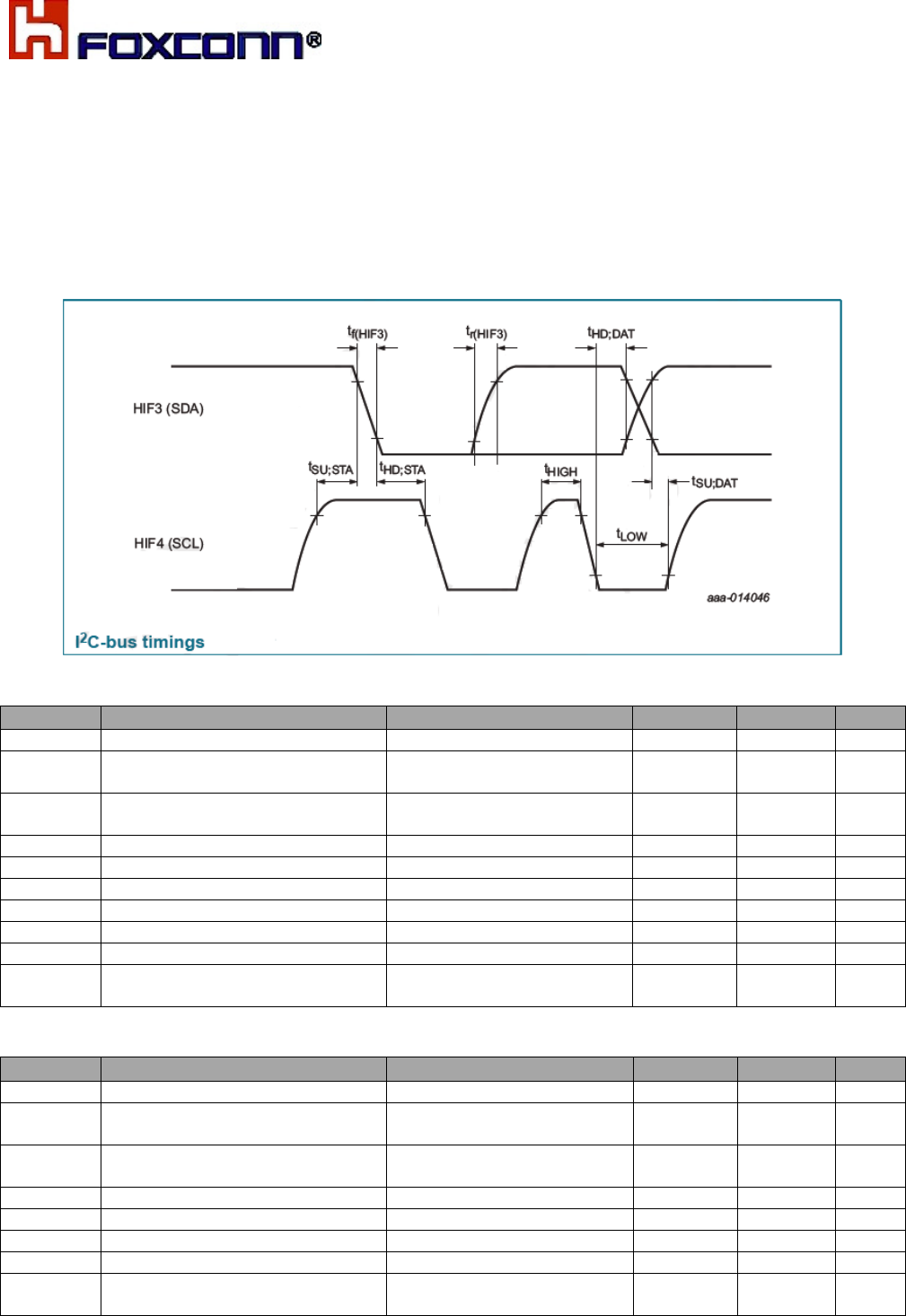
COMPANY CONFIDENTIAL
7
2.1 Host interface characteristics
I
2
C-bus Interface
The I
2
C-bus Interface implements a slave I
2
C-bus interface with integrated shift register, shift timing generation
and slave address recognition.
I
2
C-bus Standard mode (100 KHz SCL), Fast mode (400 KHz SCL) and High-speed mode (3.4 MHz SCL) are
supported.
I
2
C-bus timings
Here below are timings and frequency specifications.
High-speed mode I2C-bus timing specification
Symbol Parameter Conditions Min Max Unit
f
CLK(HIF4)
Clock frequency on pin HIF4 I
2
C-bus SCL; C
b
<100pF 0 3.4 MHz
t
SU;STA
Set-up time for a repeated
START condition C
b
<100pF 160 - ns
t
HD;STA
Hold time(repeated) START
condition C
b
<100pF 160 - ns
t
LOW
LOW period of the SCL clock C
b
<100pF 160 - ns
t
HIGH
HIGH period of the SCL clock C
b
<100pF 60 - ns
t
SU;DAT
Date set-up time C
b
<100pF 10 - ns
t
HD;DAT
Data hold time C
b
<100pF 0 - ns
t
r(HIF3)
Rise time on pin HIF3 I
2
C-bus SDA; C
b
<100pF 10 80 ns
t
f(HIF3)
Fall time on pin HIF3 I
2
C-bus SDA; C
b
<100pF 10 80 ns
V
hys
Hysteresis voltage Schmitt trigger inputs;
C
b
<100pF 0.1*V
PVDD
- V
Fast mode I2C-bus timing specification
Symbol Parameter Conditions Min Max Unit
f
CLK(HIF4)
Clock frequency on pin HIF4 I
2
C-bus SCL; C
b
<400pF 0 400 KHz
t
SU;STA
Set-up time for a repeated
START condition
C
b
<400pF 600 - ns
t
HD;STA
Hold time(repeated) START
condition
C
b
<400pF 600 - ns
t
LOW
LOW period of the SCL clock C
b
<400pF 1.3 - ns
t
HIGH
HIGH period of the SCL clock C
b
<400pF 600 - ns
t
SU;DAT
Date set-up time C
b
<400pF 100 - ns
t
HD;DAT
Data hold time C
b
<400pF 0 900 ns
V
hys
Hysteresis voltage Schmitt trigger inputs;
C
b
<400pF
0.1* V
PVDD
- V
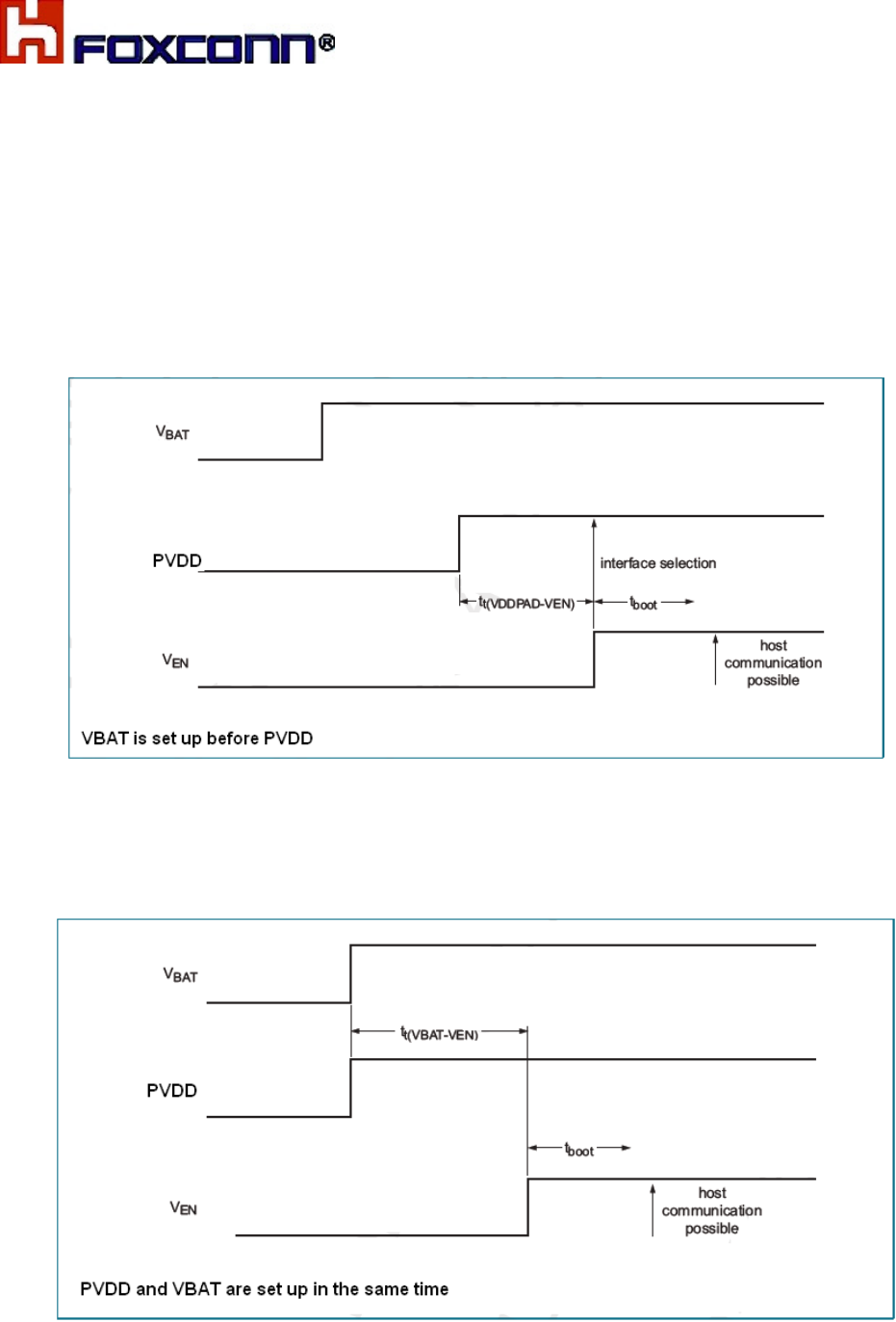
COMPANY CONFIDENTIAL
8
2.2 Power-up sequence
There are 2 different supplies for module which allows set up independently, therefore
different power-up sequences have to be considered.
1> VBAT is set up before PVDD
This is at least the case when VBAT pin is directly connected to the battery and when
module VBAT is always supplied as soon the system is supplied.
As VEN pin is referred to VBAT pin, VEN voltage shall go high after VBAT has been set.
2> PVDD and VBAT are set up in the same time
It is at least the case when VBAT pin is connected to a PMU/regulator which also supplies
PVDD.
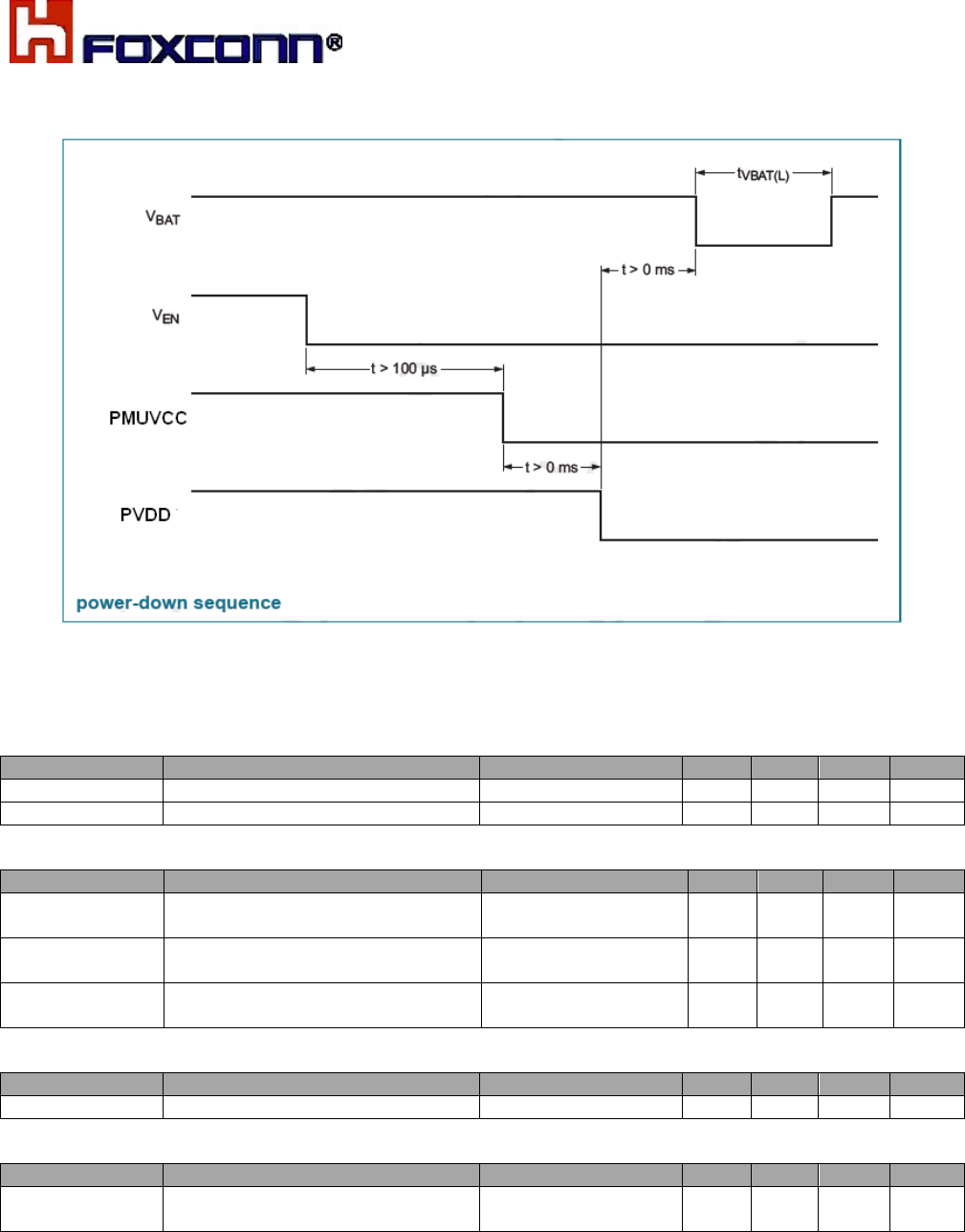
COMPANY CONFIDENTIAL
9
2.3 Power-down sequence
2.4 Function timing characteristics
Reset timing
Symbol Parameter Conditions Min Typ Max Unit
t
W(VEN)
VEN pulse width To reset 10 - - us
t
boot
Boot time - - 2.5 ms
Power-up timings
Symbol Parameter Conditions Min Typ Max Unit
t
t(V
BAT
-VEN)
Transition time from pin VBAT
to
pin VEN
VBAT,VEN
Voltage=HIGH 0 0.5 - ms
t
t(V
PVDD
-VEN)
Transition time from pin PVDD
to
pin VEN
PVDD,VEN
Voltage=HIGH 0 0.5 - ms
t
t(V
BAT
-V
PVDD
)
Transition time from pin VBAT
to
pin PVDD
VBAT,PVDD
Voltage=HIGH 0 0.5 - ms
Power-down timings
Symbol Parameter Conditions Min Typ Max Unit
t
VBAT(L)
Time V
BAT
LOW 20 - - ms
Download mode timings
Symbol Parameter Conditions Min Typ Max Unit
T
t(DWL_REQ-VEN)
Transition time from pin
DWL_REQ to pin VEN
DWL_REQ,VEN
voltage=HIGH
0 0.5 - ms
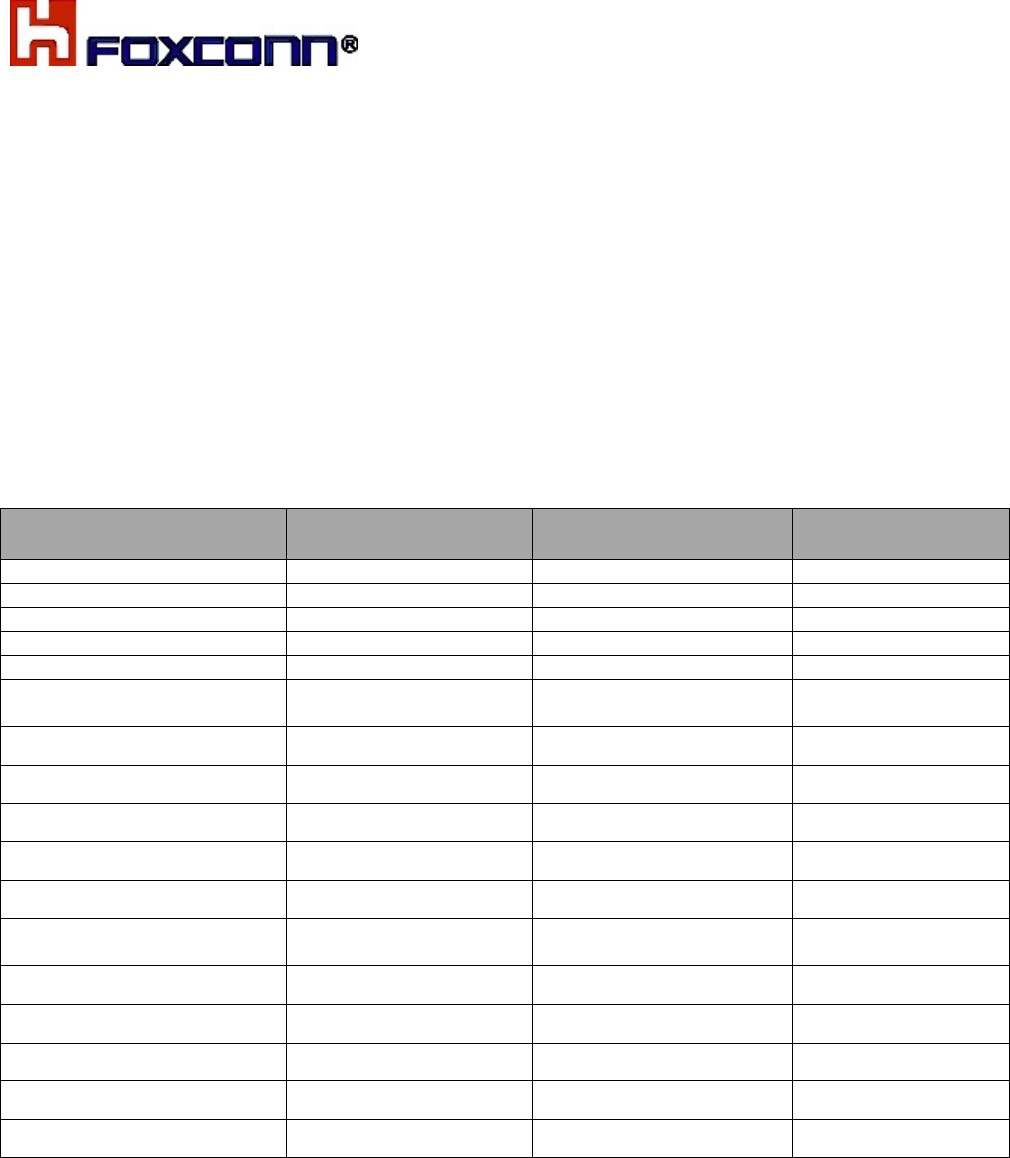
COMPANY CONFIDENTIAL
10
3. NFC contactless standard conformance
3.1 Frequency interoperability
When in communication, NFC module is generating some RF frequencies. It is also sensitive
to some RF signals as it is looking from data in the field.
In order to avoid interference with others RF communication, it is required to tune the
antenna matching for antenna board.
(Remark: The antenna matching tuning is responsible for antenna vendor)
It must limit the RF frequency dispersion to 13.56MHz +/-50ppm.
3.2 Supported smart card types
Card Types Read CSN
(Card Serial Number)
Read/Write
application data area
Supported
baud rates
NFC Forum Type1 Tag Yes Yes 106 kbps
NFC Forum Type2 Tag Yes Yes 106 kbps
NFC Forum Type3 Tag Yes Yes 212, 424 kbps
NFC Forum Type4 Tag Yes Yes 106 kbps
NFC Forum TypeV Tag Yes Yes 106 kbps
ISO/IEC 14443 Type A
compliance cards Yes Yes (with application) 106 kbps
Mifare Classics 1K,4K Yes Yes (with application) 106 kbps
Mifare DESFire Yes Yes (with application) 106 kbps
Mifare Ultralight Yes Yes (with application) 106 kbps
Mifare Plus Yes Yes (with application) 106 kbps
(Mifare) SmartMX Yes Yes (with application) 106 kbps
ISO/IEC 14443 Type B
compliance cards Yes Yes (with application) 106 kbps
FeliCa general card Yes Yes (with application) 212, 424 kbps
FeliCa Edy card Yes Yes (with application) 212, 424 kbps
FeliCa Suica card Yes Yes (with application) 212, 424 kbps
FeliCa PKI Option card Yes Yes (with application) 212, 424 kbps
HID iCLASS Seos Yes Yes (with application) 106 kbps

COMPANY CONFIDENTIAL
11
3.3 Contactless interface unit
The NFC module supports various communication modes at different transfer speeds and
modulation schemes. The following chapters give more detailed overview of selected
communication modes.
1> Reader/Writer communication modes
Generally 5 reader/writer communication modes are supported:
PCD reader/writer for ISO/IEC 14443A/MIFARE
The transfer speed includes 106 kbit/s, 212 kbit/s, 424 kbit/s and 848 kbit/s.
PCD reader/writer for ISO/IEC 14443B
The transfer speed includes 106 kbit/s, 212 kbit/s, 424 kbit/s and 848 kbit/s.
PCD reader/writer for Jewel/Topaz tags
The transfer speed includes 106 kbit/s, 212 kbit/s, 424 kbit/s and 848 kbit/s.
PCD reader/writer for FeliCa cards
The transfer speed includes 212 kbit/s, 424 kbit/s.
VCD reader/writer for ISO/IEC 15693/ICODE
The transfer speed includes 1.65 kbit/s, 26.48 kbit/s.
2> Peer to Peer communication modes
(ISO/IEC 18092, Ecma 340 NFCIP-1 communication modes)
An NFCIP-1 communication takes place between 2 devices:
NFC initiator: generates RF field at 13.56 MHz and starts the NFCIP-1communication.
NFC Target: responds to NFC initiator command either in a load modulation scheme in Passive
communication mode or using a self-generated and self-modulated RF field for Active communication
mode.
The NFCIP-1 communication differentiates between Active and Passive communication
modes.
Active communication mode means both the NFC initiator and the NFC target are using their own RF field
to transmit data
Passive communication mode means that the NFC target answers to an NFC initiator command in a load
modulation scheme. The NFC initiator is active is terms of generating the RF field.
The NFC module supports the Active Target, Active Initiator, Passive Target and Passive
Initiator communication modes at the transfer speeds 106 kbit/s, 212 kbit/s and 424 kbit/s.
3> Card communication modes
The NFC module can be addressed as an ISO/IEC 14443A or ISO/IEC 14443B cards. This
means that NFC module can generate an answer in a load modulation scheme.
The transfer speed includes 106 kbit/s, 212 kbit/s and 424 kbit/s.
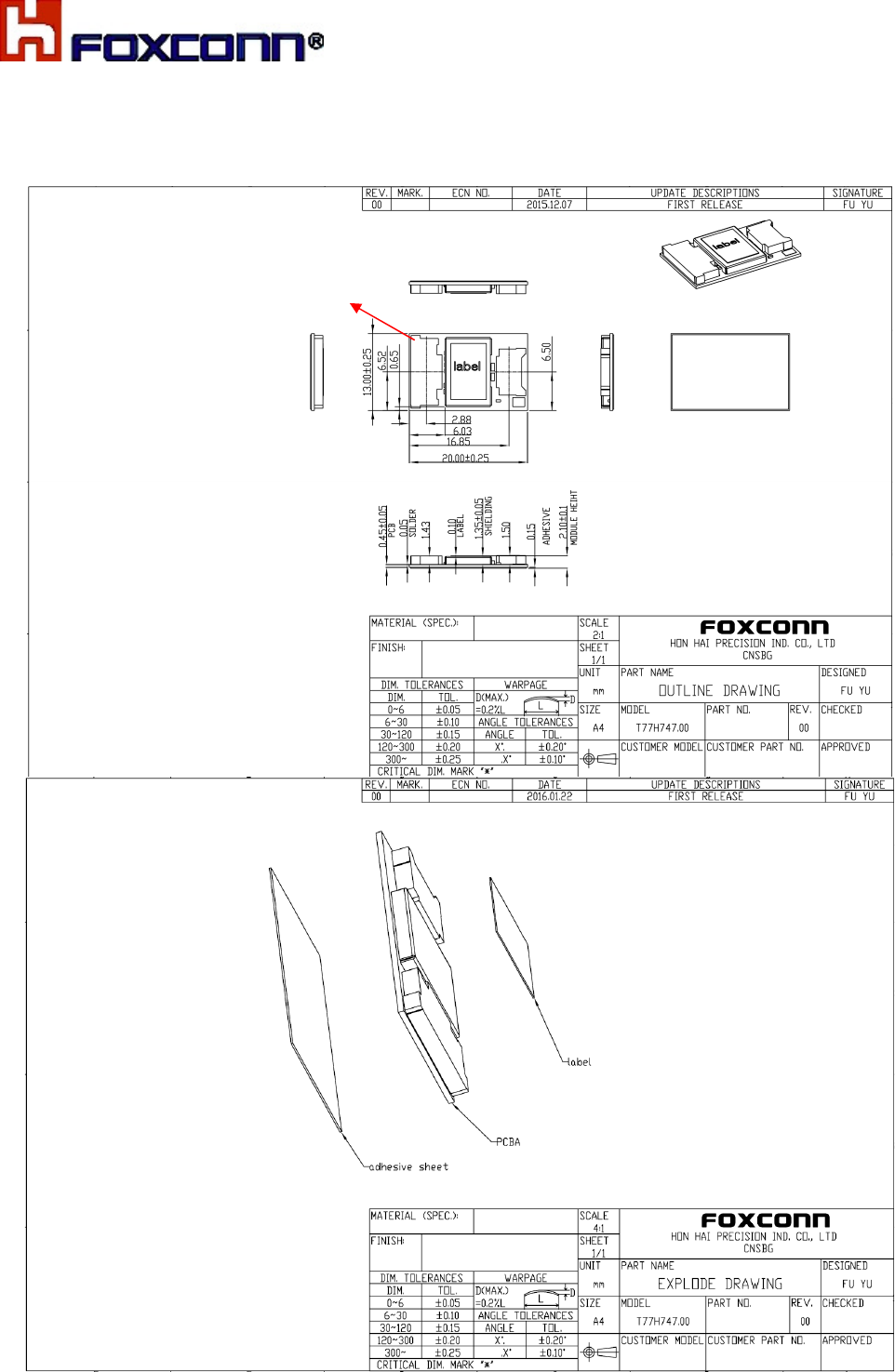
COMPANY CONFIDENTIAL
12
4. Mechanical Architecture
4.1 Module Mechanical Drawing
Dimension (WxL): 20mm x 13mm, Module Max Thickness: 2.2mm
Pin 1
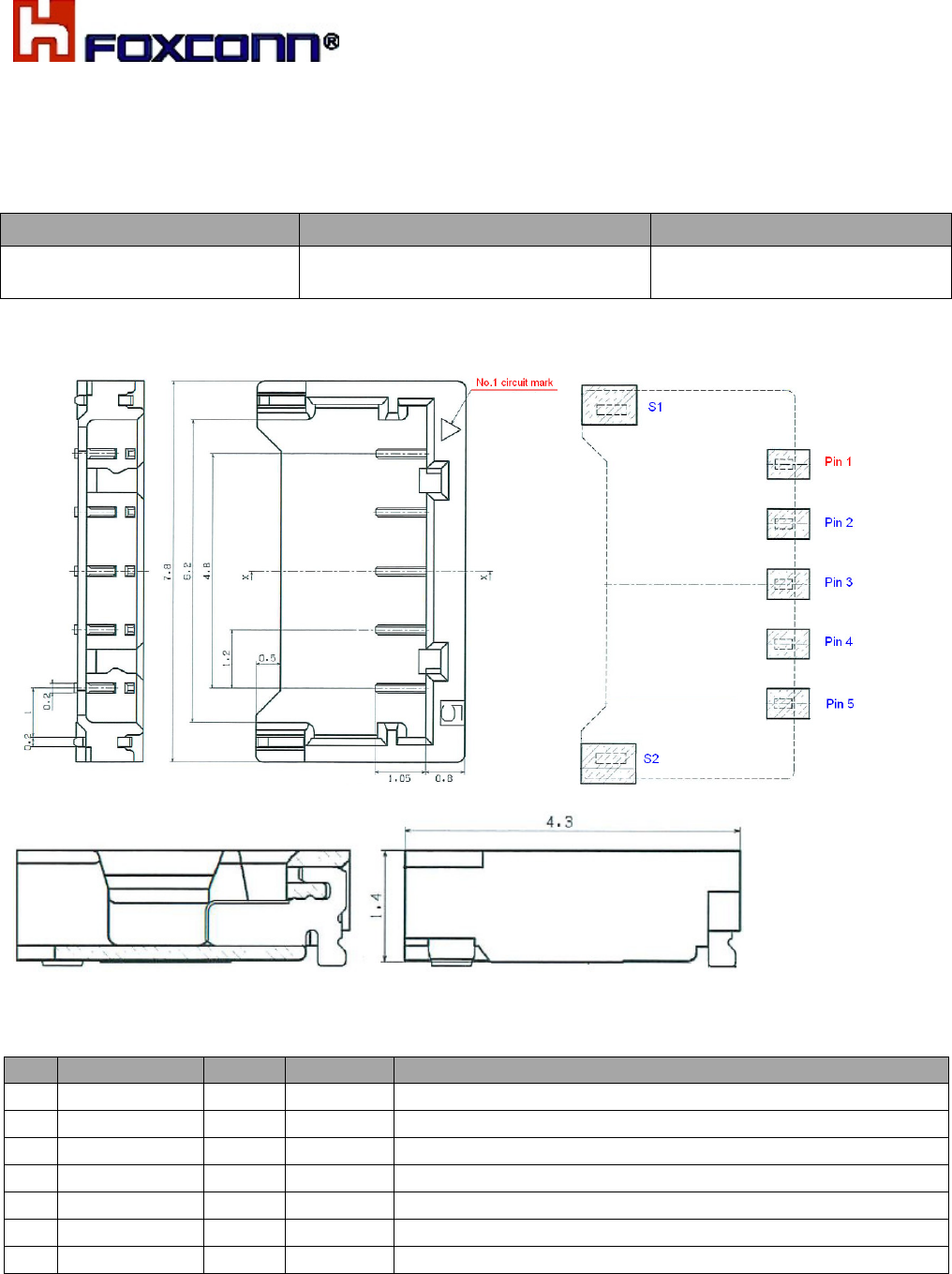
COMPANY CONFIDENTIAL
13
4.2 Antenna interface of NFC module
1> Antenna connector
Manufacturer: JST Manufacturer PN: BM05B-ACHKS-A-GAN-ETF(HF)
Connector Type Manufacture PN Size
ACH connector SMT type with
1.2mm pitch
JST : BM05B-ACHKS-A-GAN-
ETF(HF)
7.8mm x 4.3mm x 1.5mm
Connector 2D drawing:
Remark: Dimension Tolerance: +/-0.3mm
Pin definition:
Pin
Symbol I/O Refer Note
1 RXP I VDD Positive receiver input
2 TX1 O VDD Antenna output1
3 GND G N/A Ground
4 TX2 O VDD Antenna output2
5 RXN I VDD Negative receiver input
S1
GND G N/A Ground
S2
GND G N/A Ground
Remark: P = power supply, G = ground, I = input, O = output, I/O = input/output
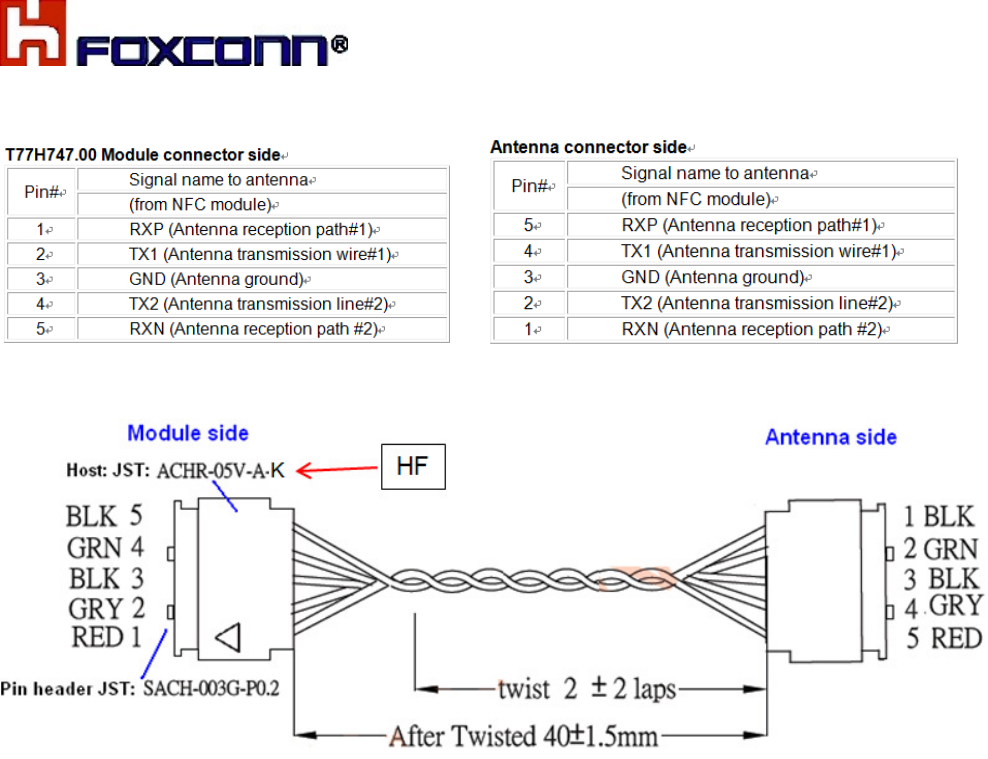
COMPANY CONFIDENTIAL
14
2> Recommend Antenna cable design.
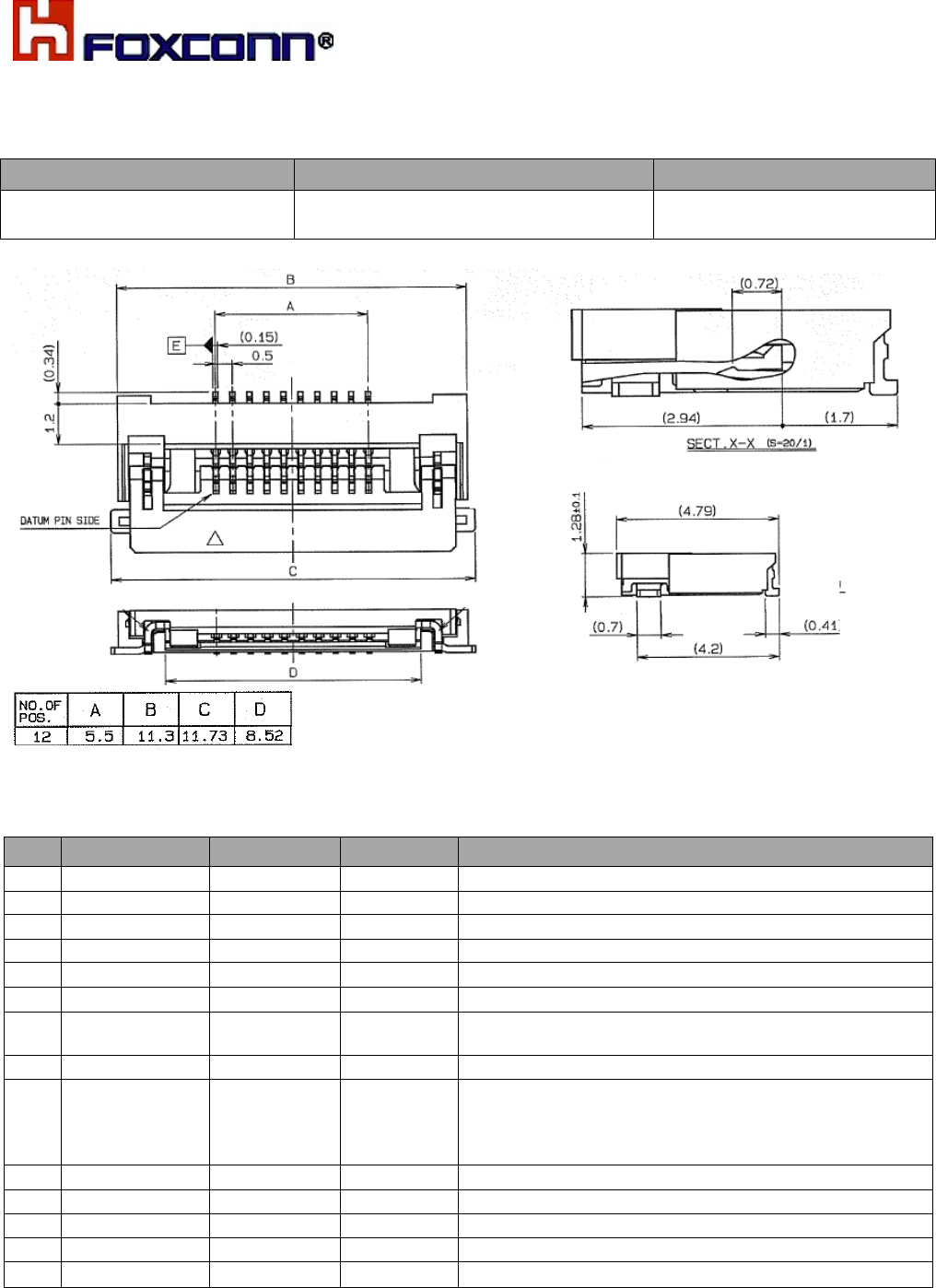
COMPANY CONFIDENTIAL
15
4.3. Host interface of NFC module
1> Host interface connector
Manufacturer: KYOCERA Manufacturer PN: 046811612000846 +
Connector Manufacture PN Size
FPC/FFC connector SMT type
with 0.5mm pitch KYOCERA: 046811612000846+ 11.73mm x 4.79mm x 1.28mm
Remark: The connector is bottom conduct with golden plating of FPC cable
Pin
Symbol Pin Type Refer Description
1 VBAT Input Power N/A Power supply from system (4.5V - 5.5V)
2 PVDD Input Power N/A Power supply to I/O (3.0V – 3.6V)
3 I2C_SDA I/O PVDD I2C data
4 I2C _SCL I PVDD I2C clock
5 GND G N/A Ground
6 IRQ O PVDD Interrupt from NFC module to the host (Host_Wake)
7 NFC_Presence
G N/A Connect to ground for NFC module presence bit (Low
active)
8 VEN I VBAT Reset pin. Set the device in Hard Power Down
9 TX_PWR_REQ
O VDD
(External TX power supply request)
(Active high 1.8V level output)
Indicates NFC busy state during NFC communication
to touchpad.
10 PMUVCC Input Power N/A Power supply to UICC(1.78V~3.3V)
11 SWIO_UICC I/O VDD(SIM) SWP data connection to SIM
12 DWL_REQ I PVDD Firmware download control pin
S1 GND G N/A Ground
S2 GND G N/A Ground
Remark: P = power supply, G = ground, I = input, O = output, I/O = input/output
Pin 1
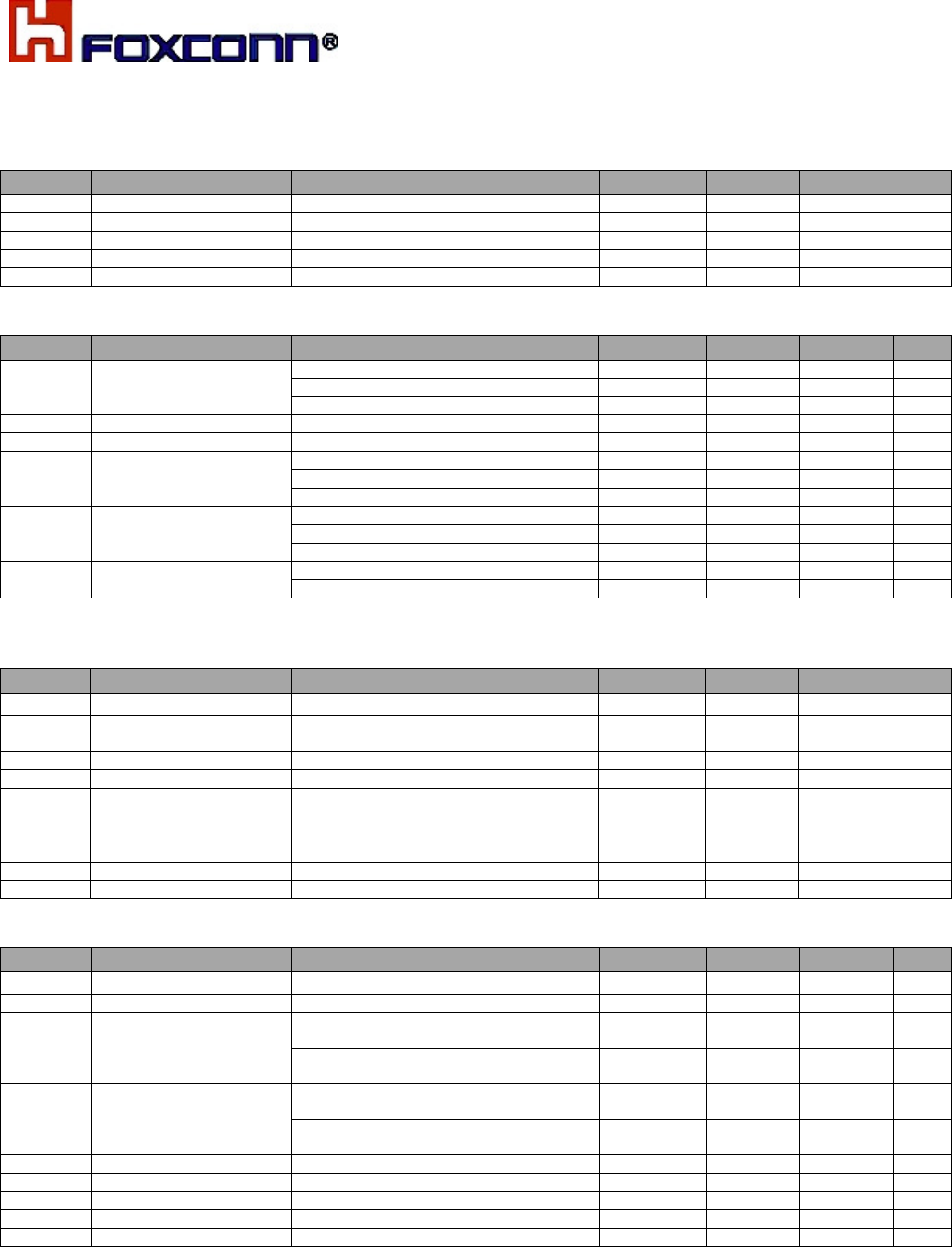
COMPANY CONFIDENTIAL
16
2> Pin characteristics
VEN input pin characteristics
Symbol
Parameter Conditions Min Typ Max Unit
V
IH
HIGH-level input voltage 1.1 - V
BAT
V
V
IL
LOW-level input voltage 0 - 0.4 V
I
IH
HIGH-level input current VEN voltage=V
BAT
- - 1 µA
I
IL
LOW-level input current VEN voltage=0V 1 - - µA
C
i
Input capacitance - 5 - pF
Pin characteristics for IRQ, and TX_PWR_REQ
Symbol
Parameter Conditions Min Typ Max Unit
V
OH
HIGH-level output voltage I
OH
<3mA - - - -
IRQ and CLK_REQ pin V
PVDD
-0.4 - V
PVDD
V
TX_PWR_REQ pin V
DD
-0.4 - V
DD
V
V
OL
LOW-level output voltage I
OL
<3mA 0 - 0.4 V
C
L
Load capacitance
- - 20 pF
t
f
Fall time C
L
=12pF max
High speed 1 - 3.5 ns
Low speed 2 - 10 ns
t
r
Rise time C
L
=12pF max
High speed 1 - 3.5 ns
Low speed 2 - 10 ns
R
pd
Pull-down resistance IRQ and CLK_REQ pins
[1]
0.35 - 0.85 MΩ
TX_PWR_REQ pin
[1]
55 - 120 kΩ
[1]
Activated in HPO and Monitor states.
Input pin characteristics for DWL_REQ
Symbol
Parameter Conditions Min Typ Max Unit
V
IH
HIGH-level input voltage V
PVDD
=1.8V 0.65*V
PVDD
- - V
V
IL
LOW-level input voltage V
PVDD
=1.8V - - 0.35*V
PVDD
V
V
IH
HIGH-level input voltage V
PVDD
=3V
2 - - V
V
IL
LOW-level input voltage V
PVDD
=3V - - 0.8 V
I
IH
HIGH-level input current - - 1 µA
I
IL
LOW-level input curent 1 - - µA
C
i
Input capacitance - 5 - pF
R
pd
Pull down resistance Extra pull-down 0.35 - 0.85 MΩ
Pin characteristics for HIF3(used as I
2
C-bus SDA) and HIF4(used as I
2
C-bus SCL)
Symbol
Parameter Conditions Min Typ Max Unit
V
OL
LOW-level output voltage I
OL
<3mA
[1]
0 - 0.4 V
C
L
Load capacitance - - 10 pF
t
f
Fall time C
L
=100 pF;
[1]
R
pull
-
up
=2kΩ; Standard and Fast mode
30 - 250 ns
C
L
=100 pF;
[1]
R
pull
-
up
=1kΩ; High-speed mode
80 - 110 ns
t
r
Rise time C
L
=100 pF;
[1]
R
pull
-
up
=2kΩ; Standard and Fast mode
30 - 250 ns
C
L
=100 pF;
[1]
R
pull
-
up
=1kΩ; High-speed mode
10 - 100 ns
V
IH
HIGH-level input voltage 0.7 *V
PVDD
- V
PVDD
V
V
IL
LOW-level input voltage 0 - 0.3*V
PVDD
V
I
IH
HIGH-level input current V
I
= V
PVDD
; high impedance - - 1 µA
I
IL
LOW-level input current V
I
=0V; high impedance -1 - - µA
C
i
Input capacitance - 5 - pF
[1]
Only for pin HIF3(I
2
C-bus SDA), HIF4(I
2
C-bus SCL) is only used as input.
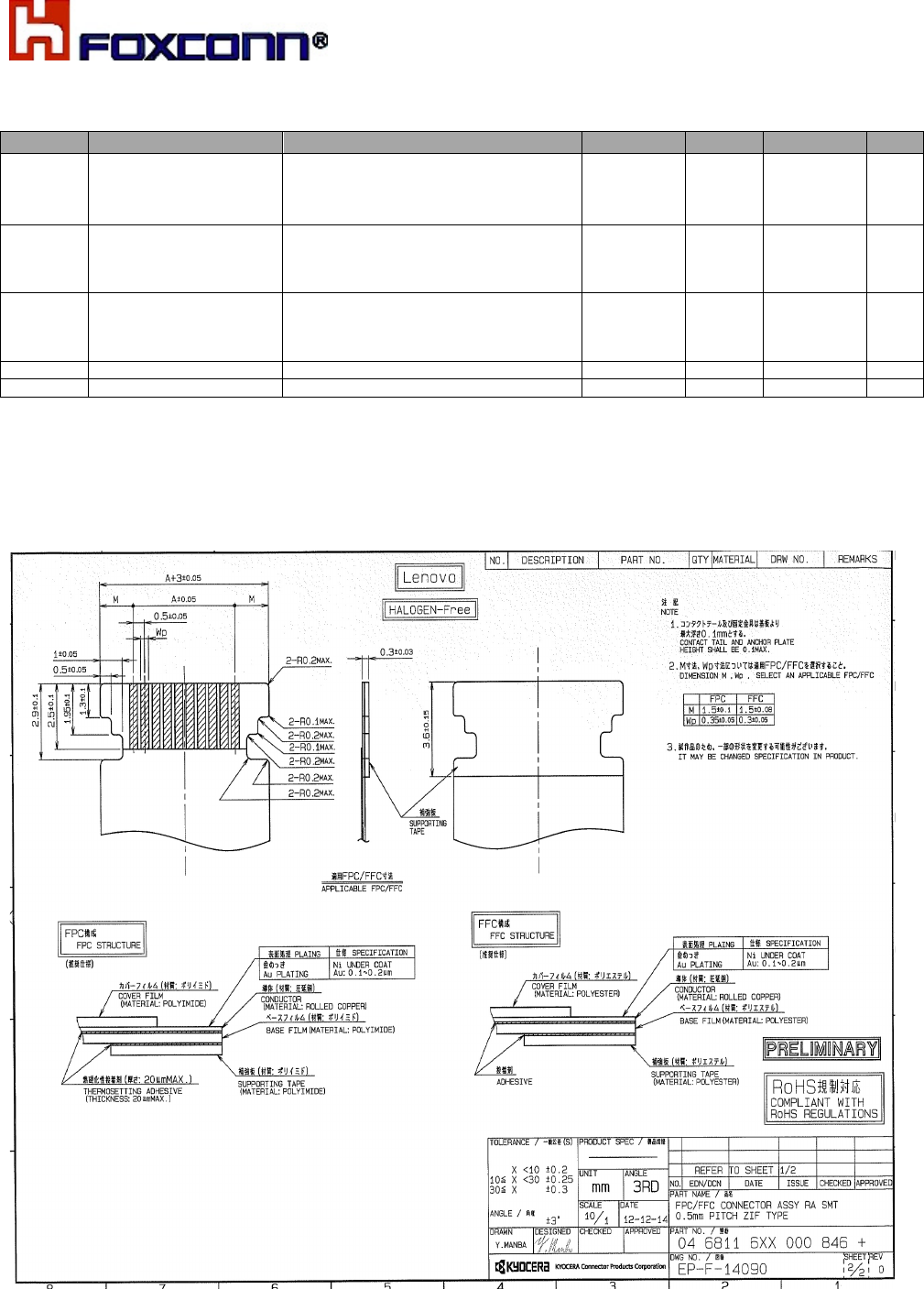
COMPANY CONFIDENTIAL
17
SWIO_UICC pin characteristics
Symbol Parameter Conditions Min Typ Max Unit
V
OH
HIGH-level output voltage I
IH
=1mA;
[1]
I
DD(SIM)
=50mA;
V
DD(SIM_PMU)
=2.75V;
V
DD(SIM_PMU)
in class B
1.4 - - V
V
OH
HIGH-level output voltage I
SIM_SWIO
=1mA;
[1]
I
DD(SIM)
=30mA;
V
DD(SIM_PMU)
=1.67V;
V
DD(SIM_PMU)
in class C
0.85 V
DD(SIM)
- - V
V
OH
HIGH-level output voltage I
IH
=1mA;
[1]
I
DD(SIM)
=5mA;
V
DD(SIM_PMU)
=0V;
V
DD(SIM)
-V
DDD
0.85 V
DD(SIM)
- - V
V
OL
LOW-level output voltage 0µA<I
IL
<20Μa
[1]
- - 0.15V
DD(SIM)
V
I
IH
HIGH-level input current - 300 - µA
[1]
To allow for overshoot, the voltage on SWIO shall remain between -0.3V and V
OHmax
+0.3V during dynamic
operation.
3> Recommend FPC cable
.
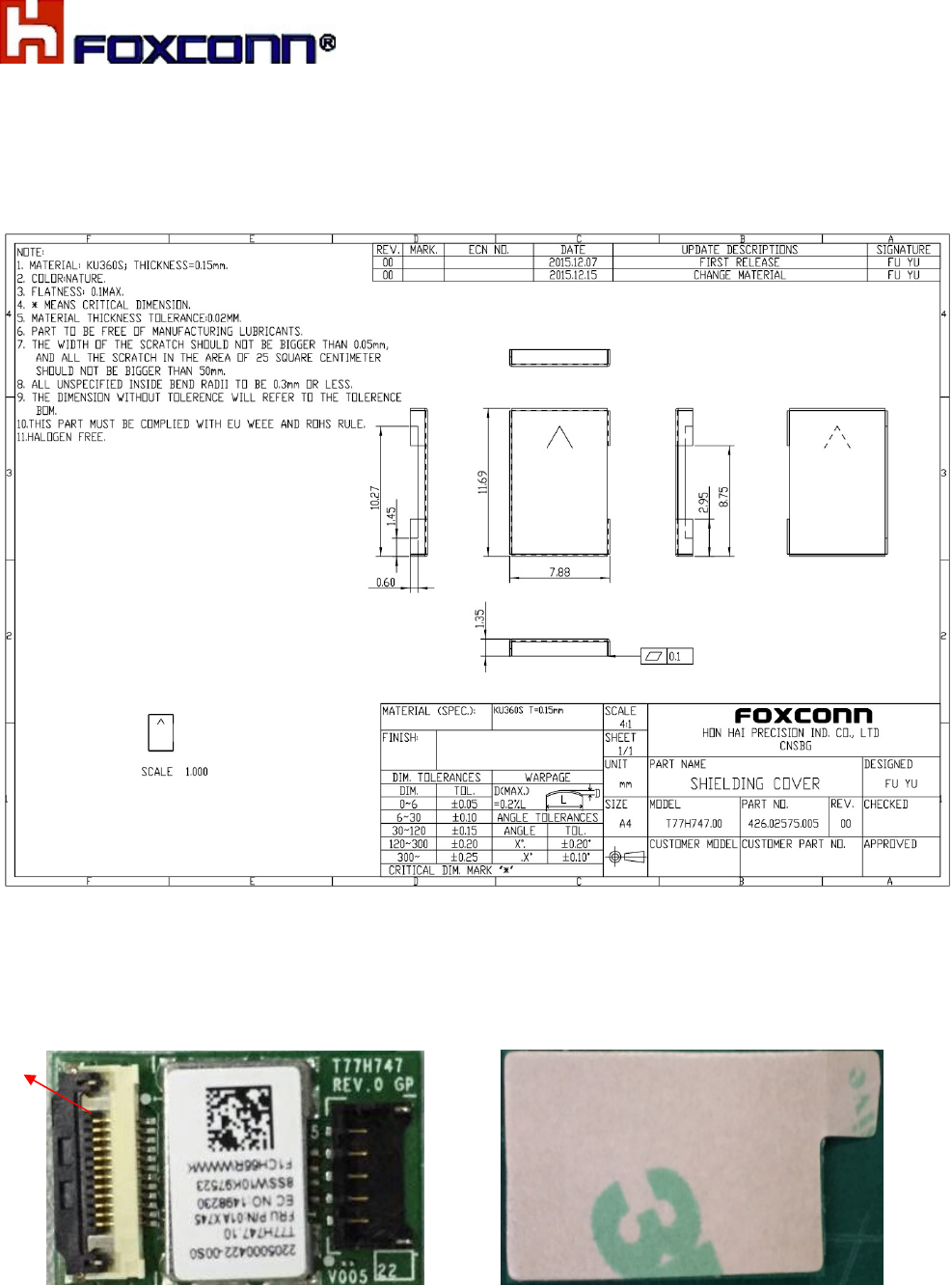
COMPANY CONFIDENTIAL
18
4.4. Shielding Cover of NFC module
Dimension (L x W x H): 11.69mm x 7.88mm x 1.35mm, Thickness: 0.15mm
Materials: KU360S
4.5. Picture of NFC module
(Top view) (Bottom view)
Pin 1
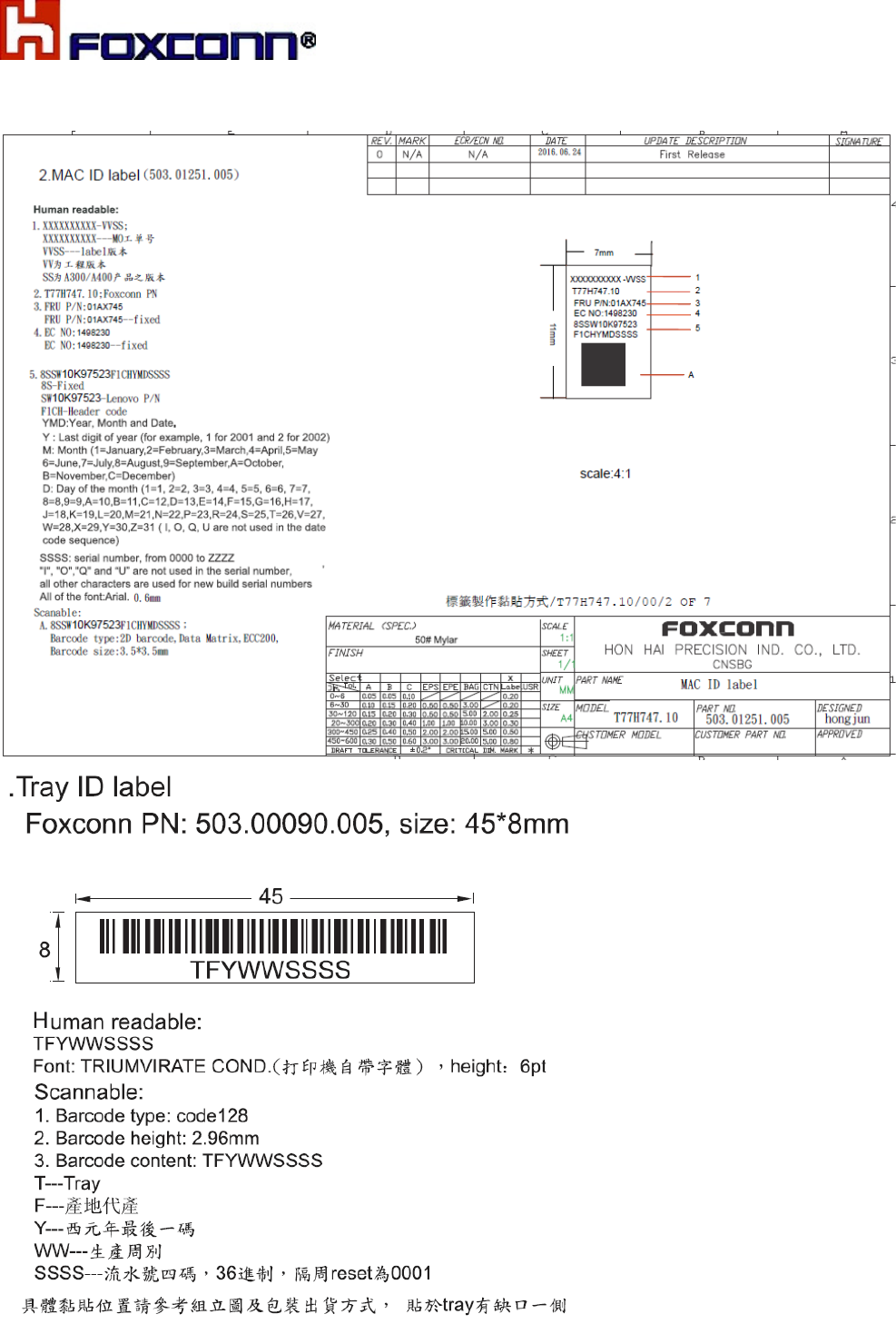
COMPANY CONFIDENTIAL
21
7. Marking Information
Label information
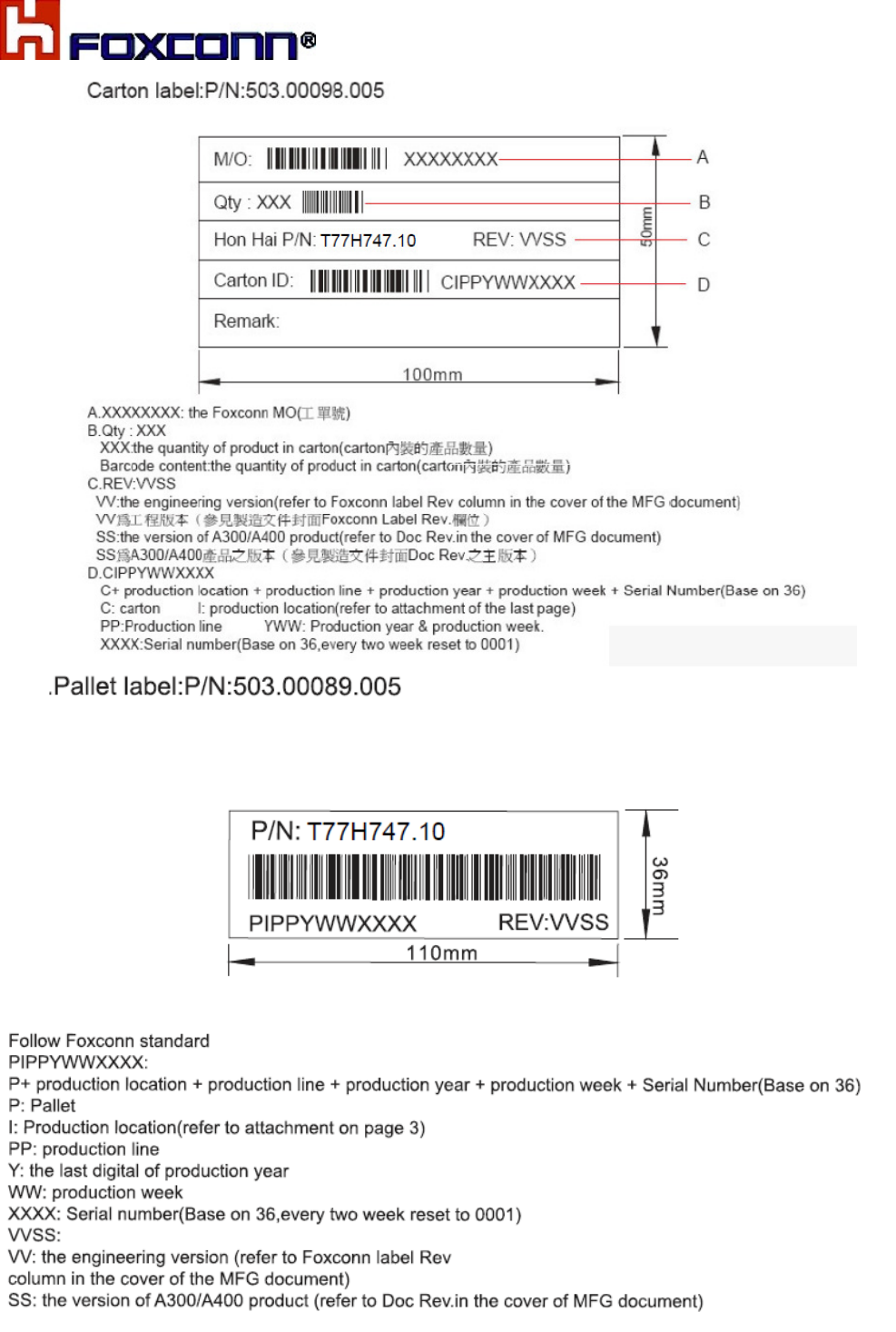
COMPANY CONFIDENTIAL
22
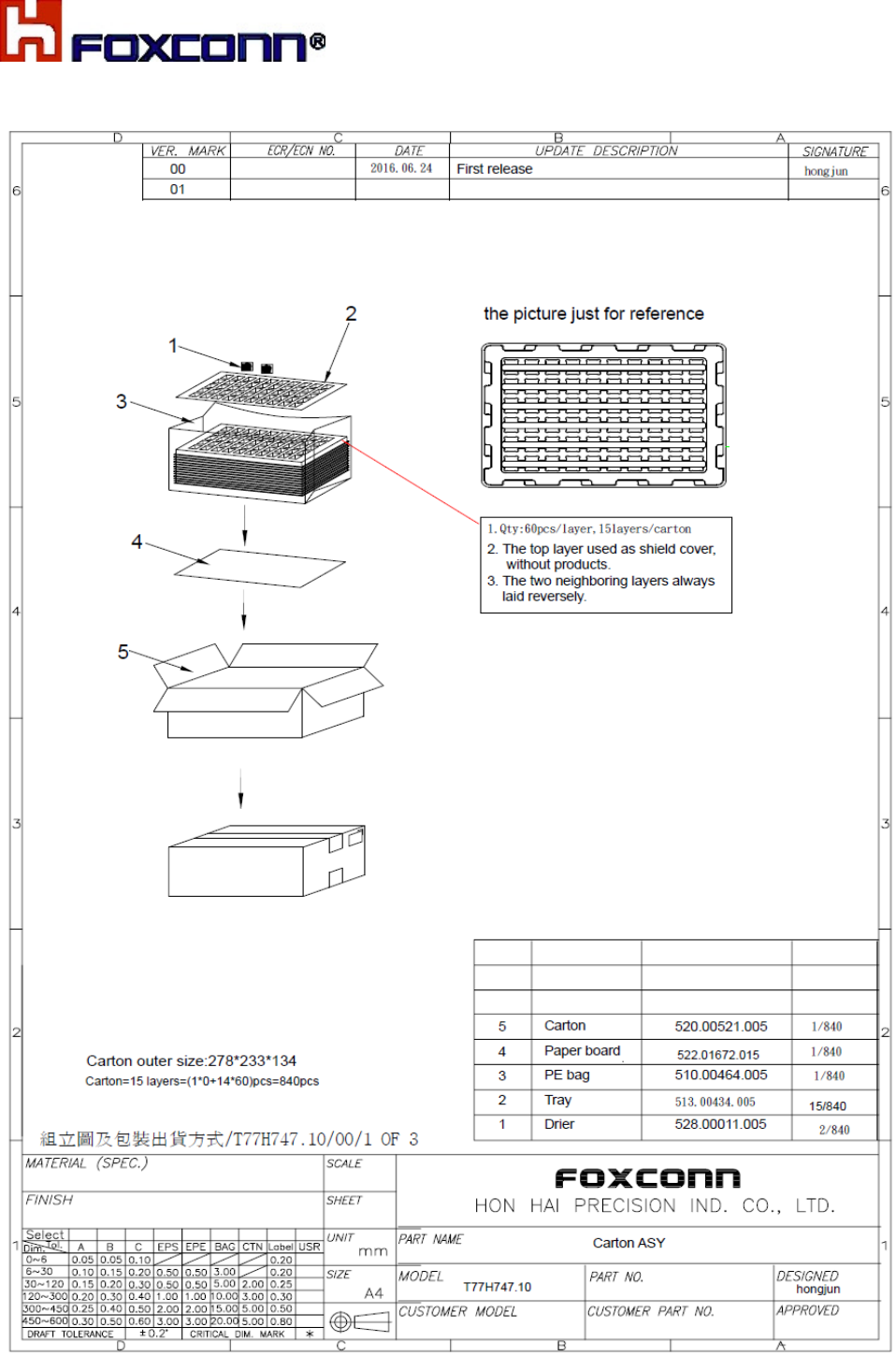
COMPANY CONFIDENTIAL
23
8. Packing information
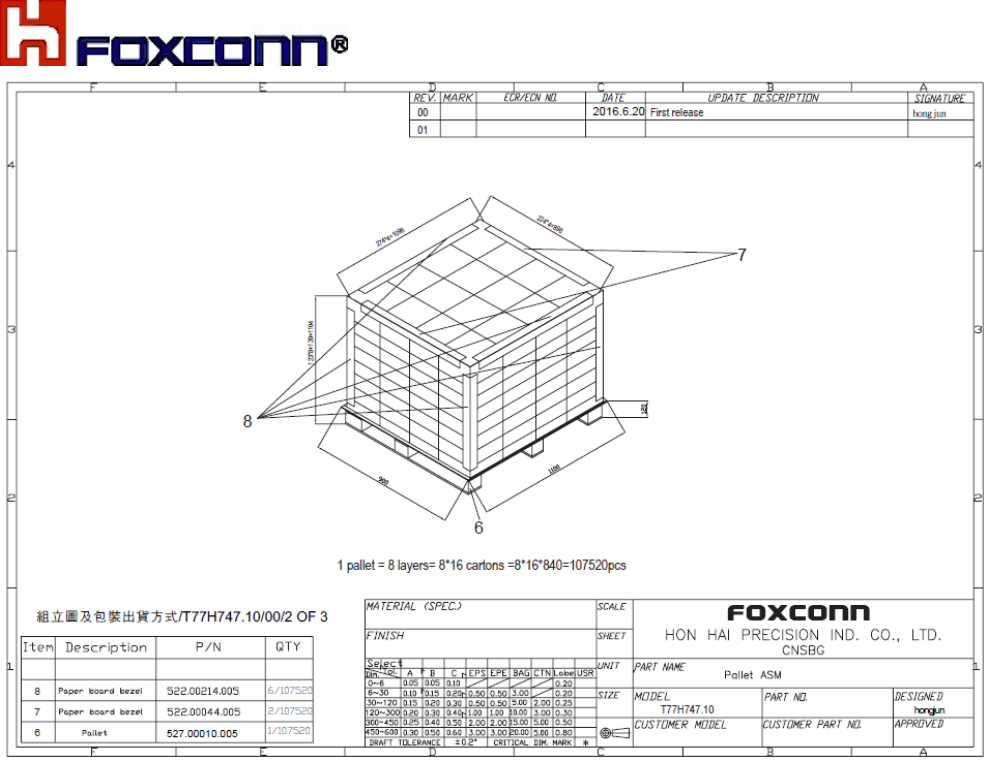
COMPANY CONFIDENTIAL
24
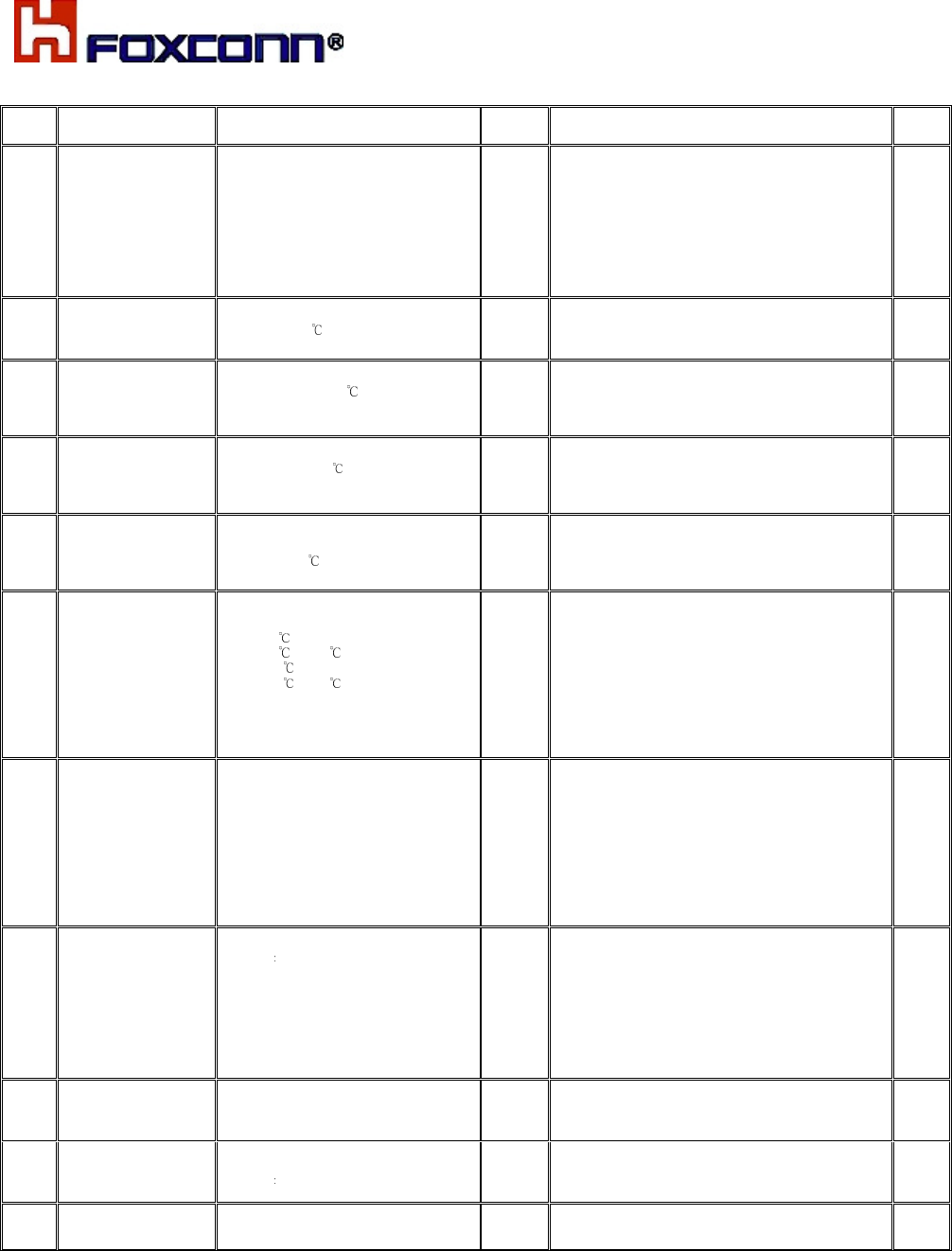
COMPANY CONFIDENTIAL
25
9. Reliability Test plan
No Item Test Condition Qty Criteria Result
1
Pull test & Cross
Section (2pcs)
Cross Section: 1pcs
Pull Test: 1pcs
1. Visual inspection: All locations
2. Cross section:
BGA/Connector/PTH Hole/Via
Hole (SMT/PIH)
3. Pull strength: 0.4mm/0.5mm pitch
QFP
1. Visual Inspection – Compliance with IPC-A-610D
Class 3 & 39T0261;
2. Function test Pass;
3. Cross section
- No separation
- Allowable Crack Length: Max. 25% of pad diameter
4. Pull test
- 800g for 0.4mm pitch QFP, 1kg for 0.5mm
pitch QFP
TBD
2 Low Temperature
Test
4. Power on;
5. Temp.= -40 ;
6. Test Period = 240hrs.
2 Pls refer to ATC TBD
3 Hot Start Test
1.Power Off ,
2.Temperature=100
3.Test period=96 Hours
4.Power on 3times
2
1. Visual Inspection – Compliance with IPC-A-
610D Class 3 & 39T0261;
2. Function test Pass.
TBD
4 Cold Start Test
1.Power Off
2.Temperature=0
3.Test period=96 Hours
4.Power on 3times
2
1. Visual Inspection – Compliance with IPC-A-610D
Class 3 & 39T0261;
2. Function test Pass.
TBD
5 Temperature-Humidity
Bias (THB)
1. Power On( apply core voltage to
PCBA )
2. Temp.= 85 & Humi.= 85%R.H
3. Test period= 400 Hours
2 Pls refer to ATC TBD
6 Accelerated Thermal
Cycles (ATC)
ATC:
1.Power off
2.Ta=85 for 7.5mins
3.Ta=85 to -40 for 7.5mins
4.Ta=-40 for 7.5mins
5.Ta=-40 to 85 for 7.5mins
6.Repeat 630cycles
Cross Section(both Bright & Dark):
BGA/CONNECTOR/PTH Hole/ Via
Hole (SMT/PIH)
2
1. Visual Inspection – Compliance with IPC-A-610D
Class 3 & 39T0261;
2. Function test Pass;
3. Cross section ( AFTER 630 cycles )
- No separation
- Allowable Crack Length: Max. 25% of pad diameter
TBD
7
Sine
Vibration(Unpackaged
)
1. Frequency = 5 ~ 500 ~ 5 HZ;
2. Acceleration = 2 G;
3. Sweep time: 3mins/cycle;
4. Each of x, y, z axis/ 30 min;
5. Power on and continuously ping
AP/SG./Golden(AP for WLAN, SG for
WWAN, Golden for BT)
6. Product need to be connected with
the mating connector which used in
laptop.
2
1. Visual Inspection – Compliance with IPC-A-610D
Class 3 & 39T0261;
2. Function test Pass;
3. No disconnect between device & AP/SG /Golden
during the test .
TBD
8 Shock
Test(Unpackaged)
1. Half-Sine wave ,50G , 11msec
2. Test +/- x, y, z axes
3. Three shock per axes, total 18
shocks.
4. Product need to be connected with
the mating connector which used in
laptop.
5. Detect by an electrical discontinuity
monitor.
2
1. Visual Inspection – Compliance with IPC-A-610D
Class 3 & 39T0261;
2. No electrical discontinuity is greater than 1
microsecond.
TBD
9 Sine
Vibration(Packaged)
1. Frequency = 5 ~ 500 ~ 5 HZ;
2. Acceleration = 2 Grms;
3. Each of x, y, z axis/ 30 mins.
1
Carton
1. Visual Inspection – Compliance with IPC-A-610D
Class 3 & 39T0261;
2. Function test Pass.
TBD
10 Shock
Test(Packaged)
1. Sine wave ,230G , 3msec ;
2. Test +/- x, y, z axes
1
Carton
1. Visual Inspection – Compliance with IPC-A-610D
Class 3 & 39T0261;
2. Function test Pass.
TBD
11 Tin Wisker 1. Power off 60/95%RH for 2000hrs;
2. Room Temperature 2000hrs. 10 Whisker Length <50um TBD

COMPANY CONFIDENTIAL
26
10. Notice
Operating Temperature Conditions
The product shall be capable of continuous reliable operation when operating in ambient
temperature of 0°C to 70°C.
Non-Operating Temperature Conditions
Neither subassembly shall be damaged nor shall the operational performance be degraded
when restored to the operating temperature when exposed to storage temperature in the
range of -20°C to +85°C.
Operating Humidity Conditions
The product shall be capable of continuous reliable operation when subjected to relative
humidity in the range of 0% and 85% non-condensing.
Handling Environment
Please make sure to avoid mechanical shock and vibration for this module.
Please do not drop the module.
Please do not clean the module.
FederalCommunicationCommissionInterferenceStatement
ThisdevicecomplieswithPart15oftheFCCRules.Operationissubjecttothefollowingtwo
conditions:(1)Thisdevicemaynotcauseharmfulinterference,and(2)thisdevicemustacceptany
interferencereceived,includinginterferencethatmaycauseundesiredoperation.
ThisequipmenthasbeentestedandfoundtocomplywiththelimitsforaClassBdigitaldevice,
pursuanttoPart15oftheFCCRules.Theselimitsaredesignedtoprovidereasonableprotection
againstharmfulinterferenceinaresidentialinstallation.Thisequipmentgenerates,usesandcan
radiateradiofrequencyenergyand,ifnotinstalledandusedinaccordancewiththeinstructions,may
causeharmfulinterferencetoradiocommunications.However,thereisnoguaranteethat
interferencewillnotoccurinaparticularinstallation.Ifthisequipmentdoescauseharmful
interferencetoradioortelevisionreception,whichcanbedeterminedbyturningtheequipmentoff
andon,theuserisencouragedtotrytocorrecttheinterferencebyoneofthefollowingmeasures:
‐ Reorientorrelocatethereceivingantenna.
‐ Increasetheseparationbetweentheequipmentandreceiver.
‐ Connecttheequipmentintoanoutletonacircuitdifferentfromthat
towhichthereceiverisconnected.
‐ Consultthedealeroranexperiencedradio/TVtechnicianforhelp.
FCCCaution:Anychangesormodificationsnotexpresslyapprovedbythepartyresponsiblefor
compliancecouldvoidtheuser'sauthoritytooperatethisequipment.
Thistransmittermustnotbeco‐locatedoroperatinginconjunctionwithanyotherantennaor
transmitter.
RadiationExposureStatement:
ThisequipmentcomplieswithFCCradiationexposurelimitssetforthforanuncontrolledenvironment.
Thisequipmentshouldbeinstalledandoperatedwithminimumdistance20cmbetweentheradiator
&yourbody.

ThisdeviceisintendedonlyforOEMintegratorsunderthefollowingconditions:
Theantennamustbeinstalledsuchthat20cmismaintainedbetweentheantennaandusers,and
Thetransmittermodulemaynotbeco‐locatedwithanyothertransmitterorantenna.
Aslongas2conditionsabovearemet,furthertransmittertestwillnotberequired.However,theOEM
integratorisstillresponsiblefortestingtheirend‐productforanyadditionalcompliancerequirements
requiredwiththismoduleinstalled
IMPORTANTNOTE:Intheeventthattheseconditionscannotbemet(forexamplecertainlaptop
configurationsorco‐locationwithanothertransmitter),thentheFCCauthorizationisnolonger
consideredvalidandtheFCCIDcannotbeusedonthefinalproduct.Inthesecircumstances,theOEM
integratorwillberesponsibleforre‐evaluatingtheendproduct(includingthetransmitter)and
obtainingaseparateFCCauthorization.
EndProductLabeling
Thistransmittermoduleisauthorizedonlyforuseindevicewheretheantennamaybeinstalledsuch
that20cmmaybemaintainedbetweentheantennaandusers.Thefinalendproductmustbelabeled
inavisibleareawiththefollowing:“ContainsFCCID:MCLT77H747”.Thegrantee'sFCCIDcanbeused
onlywhenallFCCcompliancerequirementsaremet.
ManualInformationTotheEndUser
TheOEMintegratorhastobeawarenottoprovideinformationtotheenduserregardinghowto
installorremovethisRFmoduleintheuser’smanualoftheendproductwhichintegratesthis
module.
Theendusermanualshallincludeallrequiredregulatoryinformation/warningasshowinthismanual.
IndustryCanadastatement:
ThisdevicecomplieswithISED’slicence‐exemptRSSs.Operationissubjecttothefollowingtwo
conditions:(1)Thisdevicemaynotcauseharmfulinterference,and(2)thisdevicemustacceptany
interferencereceived,includinginterferencethatmaycauseundesiredoperation.
LeprésentappareilestconformeauxCNRd’ISEDapplicablesauxappareilsradioexemptsdelicence.
L’exploitationestautoriséeauxdeuxconditionssuivantes:(1)ledispositifnedoitpasproduirede
brouillagepréjudiciable,et(2)cedispositifdoitacceptertoutbrouillagereçu,ycomprisunbrouillage
susceptibledeprovoquerunfonctionnementindésirable.
RadiationExposureStatement:
ThisequipmentcomplieswithISEDradiationexposurelimitssetforthforanuncontrolled
environment.Thisequipmentshouldbeinstalledandoperatedwithminimumdistance20cm
betweentheradiator&yourbody.
Déclarationd'expositionauxradiations:
Cetéquipementestconformeauxlimitesd'expositionauxrayonnementsISEDétabliespourun
environnementnoncontrôlé.Cetéquipementdoitêtreinstalléetutiliséavecunminimumde20cm
dedistanceentrelasourcederayonnementetvotrecorps.
ThisdeviceisintendedonlyforOEMintegratorsunderthefollowingconditions:(Formoduledevice
use)
1)Theantennamustbeinstalledsuchthat20cmismaintainedbetweentheantennaandusers,and
2)Thetransmittermodulemaynotbeco‐locatedwithanyothertransmitterorantenna.
Aslongas2conditionsabovearemet,furthertransmittertestwillnotberequired.However,theOEM
integratorisstillresponsiblefortestingtheirend‐productforanyadditionalcompliancerequirements
requiredwiththismoduleinstalled.
CetappareilestconçuuniquementpourlesintégrateursOEMdanslesconditionssuivantes:(Pour
utilisationdedispositifmodule)
1)L'antennedoitêtreinstalléedetellesortequ'unedistancede20cmestrespectéeentrel'antenne
etlesutilisateurs,et2)Lemoduleémetteurpeutnepasêtrecoïmplantéavecunautreémetteurou
antenne.
Tantqueles2conditionsci‐dessussontremplies,desessaissupplémentairessurl'émetteurneseront
pasnécessaires.Toutefois,l'intégrateurOEMesttoujoursresponsabledesessaissursonproduitfinal
pourtoutesexigencesdeconformitésupplémentairesrequispourcemoduleinstallé.
IMPORTANTNOTE:
Intheeventthattheseconditionscannotbemet(forexamplecertainlaptopconfigurationsor
co‐locationwithanothertransmitter),thentheCanadaauthorizationisnolongerconsideredvalidand
theICIDcannotbeusedonthefinalproduct.Inthesecircumstances,theOEMintegratorwillbe
responsibleforre‐evaluatingtheendproduct(includingthetransmitter)andobtainingaseparate
Canadaauthorization.
NOTEIMPORTANTE:
Danslecasoùcesconditionsnepeuventêtresatisfaites(parexemplepourcertainesconfigurations
d'ordinateurportableoudecertainesco‐localisationavecunautreémetteur),l'autorisationdu
Canadan'estplusconsidérécommevalideetl'IDICnepeutpasêtreutilisésurleproduitfinal.Dans
cescirconstances,l'intégrateurOEMserachargéderéévaluerleproduitfinal(ycomprisl'émetteur)et
l'obtentiond'uneautorisationdistincteauCanada.

End Product Labeling
This transmitter module is authorized only for use in device where the antenna may be installed such that 20 cm may
be maintained between the antenna and users. The final end product must be labeled in a visible area with the
following: “Contains IC: 2878D‐T77H747”.
Plaque signalétique du produit final
Ce module émetteur est autorisé uniquement pour une utilisation dans un dispositif où l'antenne peut être installée
de telle sorte qu'une distance de 20cm peut être maintenue entre l'antenne et les utilisateurs. Le produit final doit
être étiqueté dans un endroit visible avec l'inscription suivante: "Contient des IC: 2878D‐T77H747".
Manual Information To the End User
The OEM integrator has to be aware not to provide information to the end user regarding how to install or remove
this RF module in the user’s manual of the end product which integrates this module.
The end user manual shall include all required regulatory information/warning as show in this manual.
Manuel d'information à l'utilisateur final
L'intégrateur OEM doit être conscient de ne pas fournir des informations à l'utilisateur final quant à la façon d'installer
ou de supprimer ce module RF dans le manuel de l'utilisateur du produit final qui intègre ce module.
Le manuel de l'utilisateur final doit inclure toutes les informations réglementaires requises et avertissements comme
indiqué dans ce manuel.
This radio transmitter (IC: 2878D‐T77H747, Model: T77H747) has been approved by Industry Canada to operate with
the antenna types listed below with the maximum permissible gain indicated. Antenna types not included in this list,
having a gain greater than the maximum gain indicated for that type, are strictly prohibited for use with this device.
Cet émetteur radio (IC: 2878D‐T77H747, Modèle: T77H747) a été approuvé par Industrie Canada pour fonctionner
avec les types d'antenne énumérés ci‐dessous avec le gain maximal admissible indiqué. types d'antennes non inclus
dans cette liste, ayant un gain supérieur au gain maximum indiqué pour ce type, sont strictement interdits pour une
utilisation avec cet appareil.
低功率電波輻射性電機管理辦法
第十二條 經型式認證合格之低功率射頻電機,非經許可,公司、商號或使用者均不得擅自變更
頻率、加大功率或變更原設計之特性及功能。
第十四條 低功率射頻電機之使用不得影響飛航安全及干擾合法通信;經發現有干擾現象時,應
立即停用,並改善至無干擾時方得繼續使用。
前項合法通信,指依電信法規定作業之無線電通信。
低功率射頻電機須忍受合法通信或工業、科學及醫療用電波輻射性電機設備之干擾。
模組認證:
1. 本模組於取得認證後將依規定於模組本體標示審驗合格標籤。
2. 系統廠商應於平台上標示「本產品內含射頻模組: XXXyyyLPDzzzz‐x」字樣。
「電磁波曝露量MPE 標準值1mW/cm2,送測產品實測值為 0.97 mW/cm2」